Report

Idea in brief
The pace of technology-fueled change is quickening and, with it, the acceleration of global labor-market transformation. The OECD estimates that 1 billion jobs, almost one-third of all jobs worldwide, will be transformed by technology in the next decade. Millions of jobs are being displaced, but millions more are being created. The good news is those new jobs tend to pay more and offer better career opportunities. But employers are struggling to fill those jobs, and young people are struggling to access them. Most require more than a high school education and demand specific skills and experiences that can be hard to acquire and demonstrate.
These are challenging times for employers and students alike. Leading employers are moving quickly to adapt their hiring and talent-development practices by putting a greater emphasis on skills, rethinking their views on meaningful credentials and experience, and investing more in developing the workforce they need. Some companies will thrive through this turbulence while others falter, but most industries, and most economies, will be net beneficiaries of the accelerated pace of innovation.
The open question is how this impacts society. We have a once-in-a-generation opportunity to broaden the pool of people who have access to the good jobs and careers that will be increasingly plentiful in the years ahead. Career-connected learning (CCL) is the key to making those opportunities available to students who too often find access to such jobs beyond their reach. Well-designed CCL pathways close that gap by combining classroom learning with meaningful on-the-job work experience that leads to door-opening postsecondary degrees and credentials.
Forward-thinking education providers are rising to the challenge by elevating career outcomes, aligning what they teach with workforce needs, improving the quality of their programs, and partnering with employers to create hands-on work experiences for students. Some countries, such as Switzerland, Australia, Germany, and Singapore, have scaled highly effective CCL systems that are both student-centered and market-driven. They’ve rejected the false dichotomy between “academic instruction” and “career education” and built educational pathways that provide both, while meeting the needs of students and employers alike.
Other countries are taking notice. In the United States, we’ve seen a great deal of progress in the development of CCL systems since our Making the Leap report in 2019. Some states have built robust systems, met employers needs at scale, and fundamentally changed the lives of their students. Others have experienced false starts and fallen short of both their expectations and the opportunity. We hope this report will accelerate progress by shining a light on how the most effective CCL systems are succeeding, highlighting potential pitfalls to be avoided, and providing a blueprint for sustained economic growth powered by equitable career access and outcomes for all students.

Chapter 1. Pathways to opportunity
Like many young people, Rolando has big dreams for the future. He wants to do what he loves and provide for his family. And after years of hard work, he’s positioned to succeed. What sets Rolando apart is how he got to this point. He didn’t do what conventional wisdom says is the “right” thing to do—work hard in high school, go straight to college, and then get a job. Instead, he forged a debt-free path to his dream job, combined learning and work, and expanded his options along the way.
Rolando grew up in Elkhart, Indiana, in a low-income family. Though diagnosed with ADHD, he was a good student, and his deep love of gaming blossomed into dreams of a future in computer programming. Rolando heard, from the ninth grade on, that he needed to get a college degree to find his way to a better future, but he didn’t see the value. Several members of his family had started college and withdrew because of the financial burden. He hoped that, after high school, he could find a job as a software developer by taking the cheapest, most expedient computer programming courses he could find.
But at the end of the 10th grade, a teacher pointed Rolando toward a brand-new career-connected learning (CCL) program coordinated by Horizon Education Alliance, in partnership with CareerWise USA. He signed onto a three-year apprenticeship with a rapidly growing Internet provider in the area, called Surf Broadband Solutions, and throughout his junior and senior years, he attended classes at his high school in the mornings and spent his afternoons working as a product solutions apprentice at Surf. Ryan Coates, Rolando’s mentor at Surf, helped him navigate his first job and a transition to a highly technical role. “In the beginning, it took time and investment on my part,” Coates says, noting that most people in the new role come in with a civil engineering college degree and then get industry training. But after a few months, Rolando, then 16, “needed almost no oversight to produce high-quality work and manage his own process outside weekly meetings.”
Rolando is now in the final year of his apprenticeship and plans to pursue a four-year degree in business with financial support by Surf. “Coming from a low-income family, this is big for us,” he says. He’s making good money, has a clear plan for the future, and is proud to contribute to his community. “Building out broadband in Elkhart feels beyond satisfying,” Rolando says. “Seeing my neighbors get Internet is really awesome. It's my home.”
Stories like Rolando’s highlight an unprecedented opportunity for both the US education system and the nation’s employers. By providing students an array of postsecondary options—including robust study-and-work programs that don’t require a four-year degree, as well as college-degree programs that are more in tune with workforce needs—it’s possible to transform an inequitable system that holds back a majority of young people and contributes to the income inequality that threatens our growth and prosperity. Learning opportunities that are more closely connected to promising careers are needed for all students, not just those students for whom the current system is working, or those for whom it fails.
These stories emerged from Bain & Company’s extensive research on career-connected learning, an educational model that brings together high schools, postsecondary institutions, and employers to create career pathways that offer an additional option to the traditional—and increasingly broken—direct-to-four-year college route. This work is an extension of our 2019 report, Making the Leap, which explored how some pioneering states, including Washington and Colorado, were making impressive progress in designing CCL systems that could one day achieve scale and regional impact.
We’ve spent the past three years working to accelerate the progress of CCL. This report presents our findings on what’s working, why it’s working, and what it will take to continue scaling the best ideas.
We’ve worked with K–12 systems in Washington, DC; Texas; Colorado; and New York that are trying to understand what happens to their alumni after graduation and how schools can improve those outcomes. We’ve worked with university systems representing nearly half a million students to help them tackle the same question. We’ve also engaged deeply with OneTen, a coalition of more than 50 large, multinational employers committed to cultivating economic opportunities for a more diverse set of future employees, focusing on Black talent. Finally, we’ve worked with system-building intermediaries, who are working to create and build career-connected learning systems at both the state and city level.
Our understanding of these issues has been immeasurably enriched by engaging with and learning from more than 2,200 young people and their families. We’ve asked them to describe in their own words what their journeys from school to work have been like and how those experiences could have been different and better. We’ve also had the opportunity to learn from thought leaders focused on CCL across the country, including Braven, CareerWise, Merit America, Propel America, Year Up, and the Pathways to Prosperity Network, as well as the US Department of Labor. We’ve spent hours talking to system builders in Delaware, Rhode Island, Washington, California, and the District of Columbia who are working on the ground every day to accelerate progress. And we’ve invested deeply in talking to employers across geographies and industries that are actively pursuing innovative solutions.
This report draws on this experience, research, and analysis to make the case that young people aren’t being adequately prepared for good jobs, and that career-connected learning—at scale—is the solution. We structured the inquiry around three main questions.
- Are we preparing our young people for good jobs today? We know from Bain’s updated analysis of more than 50 million job postings (sourced from Emsi Burning Glass, 2021) that good jobs, which pay well and are less vulnerable to automation, are plentiful today and being created at an exciting pace. And we know that employers struggle to find qualified talent for those jobs. In Chapter 2, we explore why the current system isn’t doing enough to close this gap and how young people experience a challenging transition from education to work.
- What major shifts are required to create CCL at scale? Promising CCL programs exist, but getting to scale and impact will require significant changes from both educators (K–12 and postsecondary) and employers. Chapter 3 argues that educators need to elevate career outcomes, and employers need to move from passive consumers to active creators of talent. Working together, these two groups can create mutually beneficial career pathways for students from all backgrounds.
- How can we make those shifts happen at scale? Disparate actors won’t work together at scale without some degree of support and prodding. Chapter 4 brings to life how government and system-building intermediaries can work with schools and employers to expand winning programs and take CCL to scale.
The changes we’re proposing are neither small nor easy. They require multiyear commitments from many actors working in unison. But the progress over the past three years has been inspiring, and it proves that the most important accelerant of success is success itself. What’s becoming increasingly clear is that accelerating the growth of career-connected learning is a compelling win-win. CCL is among the most effective ways to create meaningful opportunity for young people from all backgrounds. It offers employers a sustainable, profitable way to find great talent and diversify their workforces. Those successes add up to economic growth and a more equitable, productive society. The opportunity is great; the time is now.

Chapter 2. Plenty of good jobs, not enough qualified candidates
Since we published Bain’s last report on career-connected learning in 2019, the powerful forces molding the global job market have only intensified. Digital innovation continues to reshape the economy and how companies go about their business. Automation has accelerated, removing the human component from many types of repetitive jobs.
We don’t know how the Covid-19 pandemic will ultimately alter global business markets, but we know this much already: The crisis sped up digital adoption across business sectors and encouraged companies to increase investment in the kinds of technologies—automation and otherwise—that eliminate large numbers of jobs and remake others. The magnitude of the coming change is staggering. The OECD estimates that technology will transform more than 1 billion jobs by 2030.
Unsurprisingly, the apocalyptic narrative—“Robots are eating our jobs!”—gets the most attention in media and policy circles. But these ominous forecasts belie what’s really going on in the job market. The bigger story is that companies are responding to this turbulent era by creating millions of new jobs each year, and many are the kinds of jobs that can kick-start a vibrant, sustainable career.
While the World Economic Forum predicts that 85 million jobs in roles like data entry, accounting clerks, and secretaries are likely to be displaced from 2020 to 2025, 97 million new jobs are likely to be created, such as artificial intelligence specialists, data scientists, and information security analysts (see Figure 1). Bain’s analysis of 50 million real-time US job postings (sourced from Emsi Burning Glass, 2021) found that the fastest-growing job categories are six times more likely to pay over $100,000, compared with the slowest-growing ones. They’re also about half as likely to be displaced by automation.
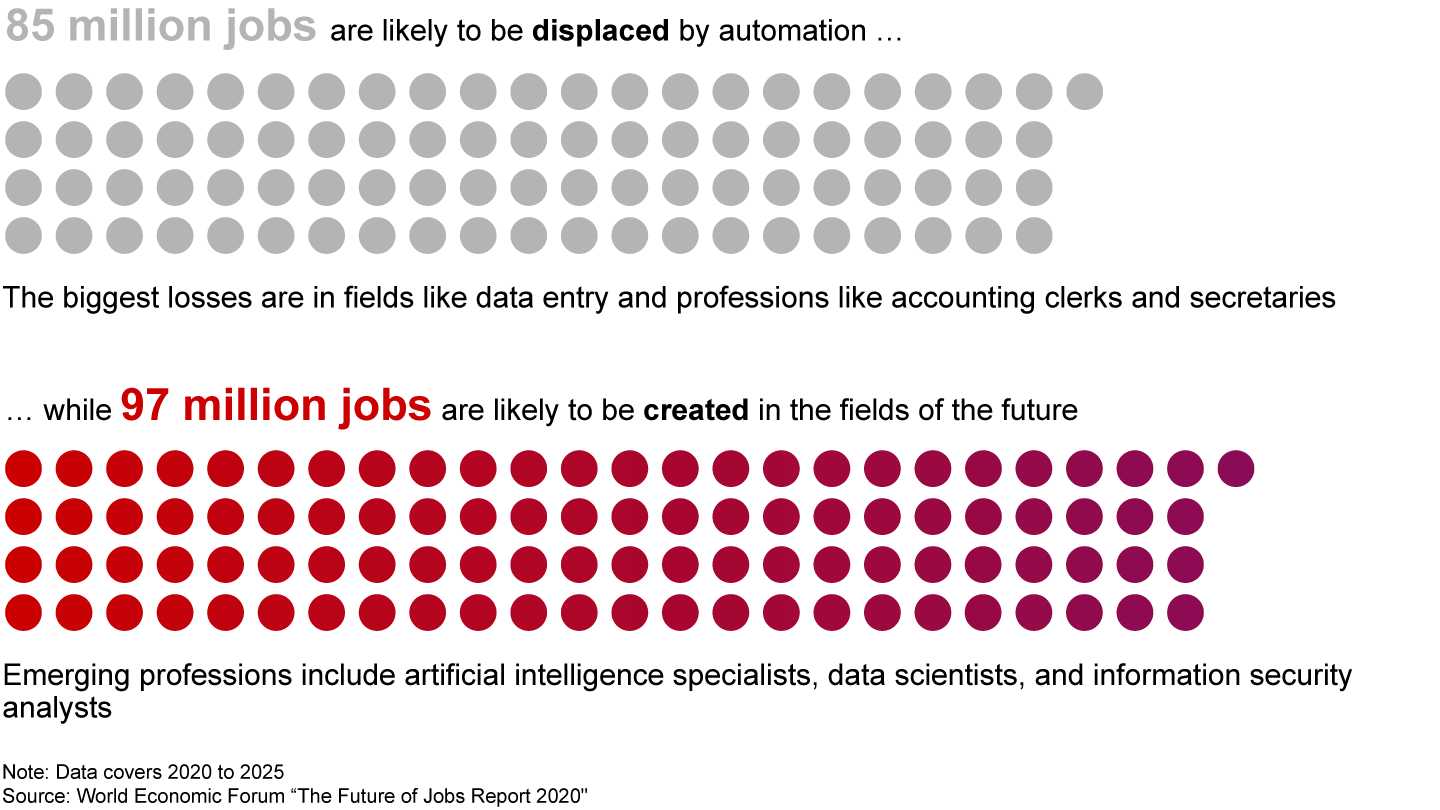
The real challenge facing markets globally is how to fill all the new jobs. As one information technology executive put it: “There is not enough talent for the work we need to do. And when we do find qualified candidates, they are in very high demand, often with four to five other offers.” The reason is that the jobs emerging on the market today require a higher skill set than the ones they’re replacing. Our analysis found that the fastest-growing jobs are 3.5 times more likely to require high-level skills than the lowest-growth jobs (see Figure 2).
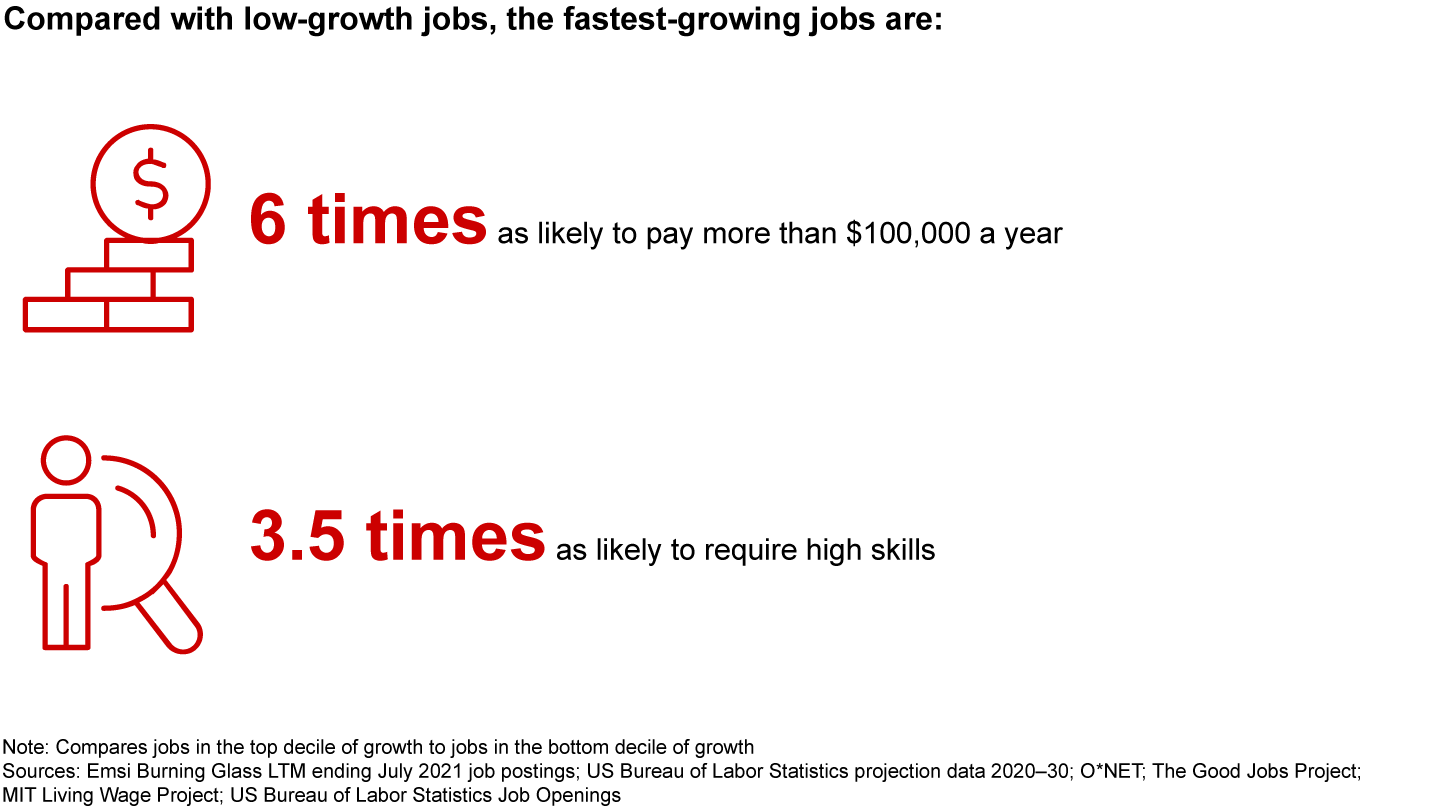
That explains why employers are clamoring for skilled workers. As of July 2021, Labor Department data shows that the US has more job openings than unemployed people. At approximately 1.3 job openings per unemployed person, this is the highest ratio recorded since tracking began in 2000 (see Figure 3).
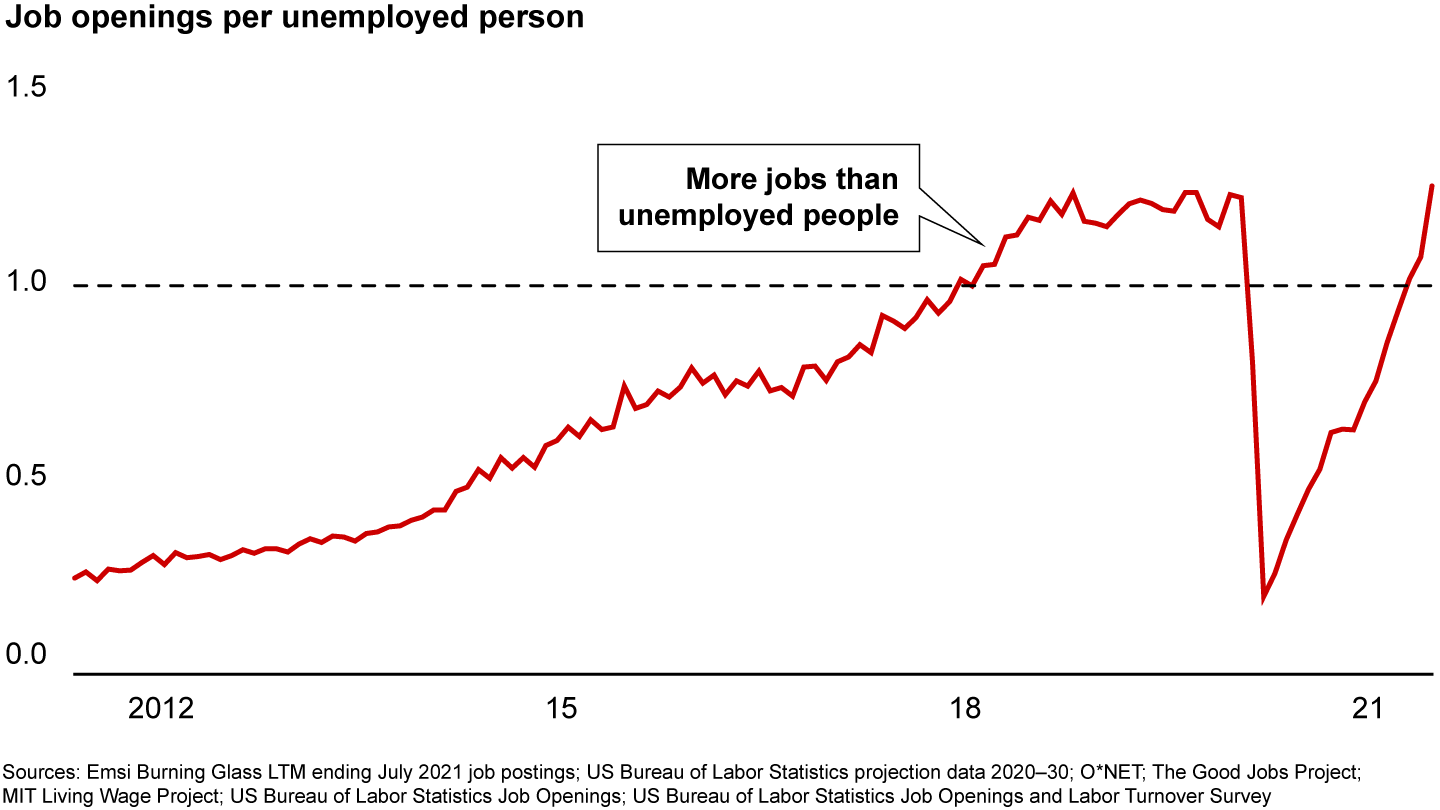
With all these high-growth, highly skilled jobs available, it stands to reason that young, tech-savvy millennials should be snapping them up. But, in fact, the opposite is true. Youth unemployment in the US, for example, has remained stubbornly high for decades, around double the total unemployment rate, despite the growth in attractive new jobs (see Figure 4). The US isn’t alone in facing this challenge (see Figure 5).
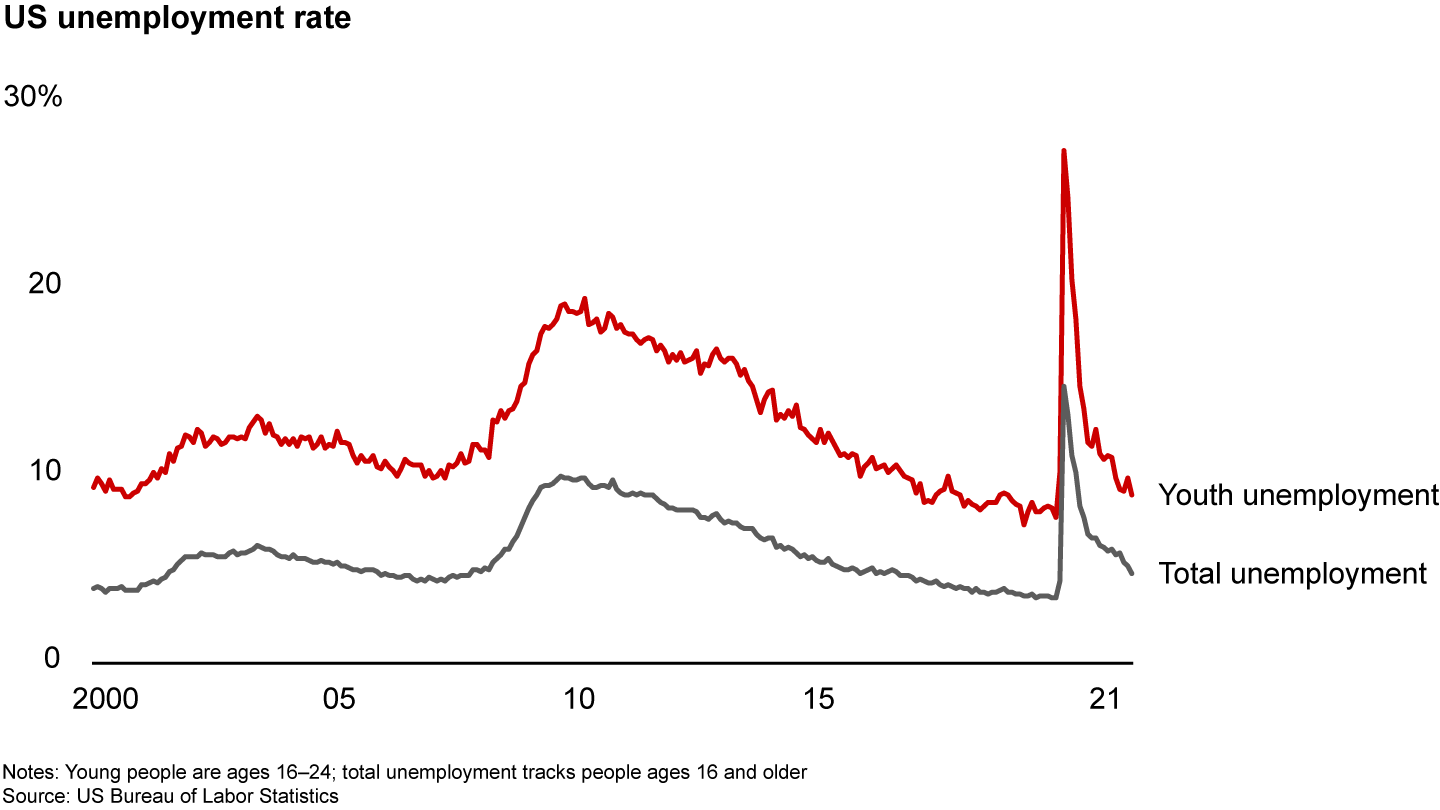

Youth underemployment, which measures the number of young people who have more education than their job requires, has also remained high in the US, with 40% of recent college graduates qualifying as underemployed.
What this all this adds up to is not a “jobs problem,” but a “skills problem.” And that translates into a failure to adequately educate students and train workers to succeed in the 21st-century economy. Employers are creating good jobs and can’t find enough qualified workers to fill them, yet our education system and the companies themselves aren’t preparing enough job candidates with the requisite skills. This is happening now, and the supply-demand imbalance in the labor market is primed to get worse. That not only threatens economic growth, but promises to widen the income inequality that has become so destabilizing around the world. For many young people on the cusp of adulthood, it’s short-circuiting their dreams of a better life and a bright future.
Falling through the cracks
This issue is most commonly framed as a failure to get enough young people to and through college, which is widely assumed to be a vital prerequisite for the kind of jobs that support a family and launch a fulfilling career. This isn’t surprising, since employers have for decades viewed a bachelor of arts or a bachelor of science as a proxy for capability, using these degrees as a minimum screening requirement for job candidates.
In many ways, this makes sense. Today’s good jobs are complex and require more skills than ever. One IT executive put it this way: “As more jobs get automated, employers will require a higher level of skill in the future, which will be difficult to find.” To acquire those skills, young people do need more than a high school education. And schools have responded accordingly, encouraging more of their students to continue their education after high school. The result is that, since 2000, the percentage of Americans age 25 to 64 with a postsecondary degree has increased from 36% to 48%. This trend is similar across OECD countries, growing from 22% to 38% on average over the past two decades, although attainment varies by race and socioeconomic status around the world.
So why aren’t all those degrees putting more young people to work in good jobs? Too often, students are spending years of time and piling up thousands of dollars in debt, only to find their college education hasn’t prepared them to obtain and succeed in good jobs.
Working closely over the past several years with one of the largest public university systems in the US gave us an up-close look at a representative slice of the college-going population. This system was founded as an engine of mobility for students in the areas it serves and was explicitly intended to provide them with an affordable and high-quality path to prosperity. It has well over 100,000 students, reflecting the diversity of the region, enrolled in two- and four-year institutions. Nearly half of the student body comes from low-income households, and the same proportion of students are the first in their family to go to college.
However, its success rate in providing pathways to good jobs is sobering. Only 1 in 5 freshmen entering this university system’s bachelor’s programs graduates and earns a living wage the first year out of school. Nearly 4 in 10 leave before graduation for a variety of reasons, including personal, financial, and academic challenges. Of those who graduate and go on to consistent employment, fewer than half were earning a living wage (see Figure 6).

To get behind the statistics and better understand what young people experience when they move from high school into the next phase of their lives, we decided to ask them directly. This involved engaging young adults individually and through focus groups. We heard firsthand from 1,000 alumni from college-preparatory high schools and 1,200 young people ages 19 to 34 who grew up in a large urban center. We focused predominantly on students from low-income communities, a population that often has the hardest time finding opportunities for economic mobility.
Our research showed that job success was hard to come by, even after investing heavily to earn a degree. Half of the young adults with a bachelor’s degree were making less than the financial stability threshold ($40,000 in one place; $44,000 in another). On average, they had accrued more than $26,000 of student debt. Approximately 35% of the degree holders were employed in jobs that didn’t require a bachelor’s degree. That makes them five times more likely to remain underemployed five years into the future.
Most of these young people aren’t feeling great about where they find themselves. Roughly 5 in 10 reported feeling financially stable. Only about one-third felt fulfilled in their careers or optimistic about the future (see Figure 7). In fact, nearly half (49%) of the bachelor’s degree holders in our city-based survey had decided to go back to school in a more career-oriented program. That meant taking on more debt and spending more years learning when they could be earning.

One college graduate we spoke with, who had grown up in the foster care system, said her stop-and-start path to a good job took years. She worked diligently in high school and was admitted to college. Her freshman year in college went OK, but when she had to take time off for personal reasons in her second year, her grades slipped, and she left school. A job at a car dealership inspired her to reenroll (“I saw that no one was making more than they did 15 years ago,” she says). She enrolled at a different institution and earned a BA in sociology. She quickly found out an undergraduate sociology degree wasn’t particularly marketable. So she took on more debt and returned to school to earn a career-focused master’s in applied sociology and eventually landed a job as an operations research analyst. Her current job has a promising career trajectory, but it came at a steep cost in both time and money. She’s confident her two degrees will pay off eventually. But right now, between the amount she’s making and her expenses, including debt, “It never feels like enough.”
Why are postsecondary institutions struggling so hard to launch students into careers? The reaction of one chagrined college president is telling. “Thinking of career outcomes is not part of our academic culture,” he explains. “We never design for what happens after graduation, we only focus on the classroom. Alignment with the workforce is a new type of thinking for our college.”
The resulting lack of alignment goes a long way toward explaining why schools have such a hard time preparing students to succeed in the job market. We see this manifest in multiple ways.
“We never design for what happens after graduation, we only focus on the classroom. Alignment with the workforce is a new type of thinking for our college.”
First, most postsecondary programs aren’t focused on the right jobs and, even when they are, aren’t teaching the skills required to succeed in good jobs.
Second, when they do offer career-focused degree programs, higher education providers often provide only classroom study, without hands-on learning through work experience. This narrow focus on “study-then-work” vs. “study-and-work” often denies students the opportunity to acquire real-world experience that would better prepare them for future jobs.
College classes that bear little connection to the outside world often feel disconnected and unengaging, calling into question the value of the experience for students. This is especially true when students are borrowing heavily and spending precious resources on expensive degrees that may or may not pay off. Since these institutions often lack effective wraparound support such as advising and counseling, many students—especially the most vulnerable—leave before graduation.
Talent takers not makers
The education system isn’t the only offender. Employers also bear responsibility for their low-flow talent pipelines. Too often, they’re talent takers rather than talent makers. Few employers are willing to meet the education system halfway when it comes to training a highly skilled workforce. Like waiting for bread from the Little Red Hen, they hope educators will simply deliver a finished product.
Employers are often reluctant to spend precious time and resources on training raw talent when the pace of innovation is so fast. Human capital development takes time, and it can often feel more expedient to hire ready-to-go talent. This helps explain why employers are spending about the same amount now on employee training per learner as they did in 2008, despite the increased complexity of the skills required. One executive we spoke with says, “We typically want to bring on people who can hit the ground running. So we’re always looking for talent that already has experience.”
At the same time, employers are wary about engaging with educators to advise on career-connected learning pathways or help build them. Executives tell us that opening the door to such contacts can quickly become overwhelming. Calls from educators come in from all directions asking for help—career fairs, job shadowing, mentorship, internships, apprenticeships. It’s hard to discern, among all the asks, what will really move the needle.
All these issues can dull employer enthusiasm for career-connected learning. But in our work, we’ve seen many examples of highly engaged companies that are having success. Hungry for new, more diverse sources of talent, they’re actively working with educational partners to build new and innovative pathways. These kinds of efforts are promising, but still rare and small scale.
An integrated approach
Connecting more young people with good jobs and bright futures will require creative solutions that extend beyond simply doing what we do today, namely attempting (and mostly failing) to send all our students from high school directly to and through college. That starts by recognizing that equipping young people to succeed in a rapidly transforming economy means building a system that does a much better job of providing young people with multiple pathways to bright futures. In other words, we need career-connected learning.
Career-connected learning is a three-phase journey: awareness, which includes experiences that expose students to the range of career options out there; preparation, which entails classroom or work-based experiences that prepare students to be successful in the workplace; and launch, which combines deeper work experience and aligned classroom learning that leads to an industry-valued credential and access to good jobs (see Figure 8).
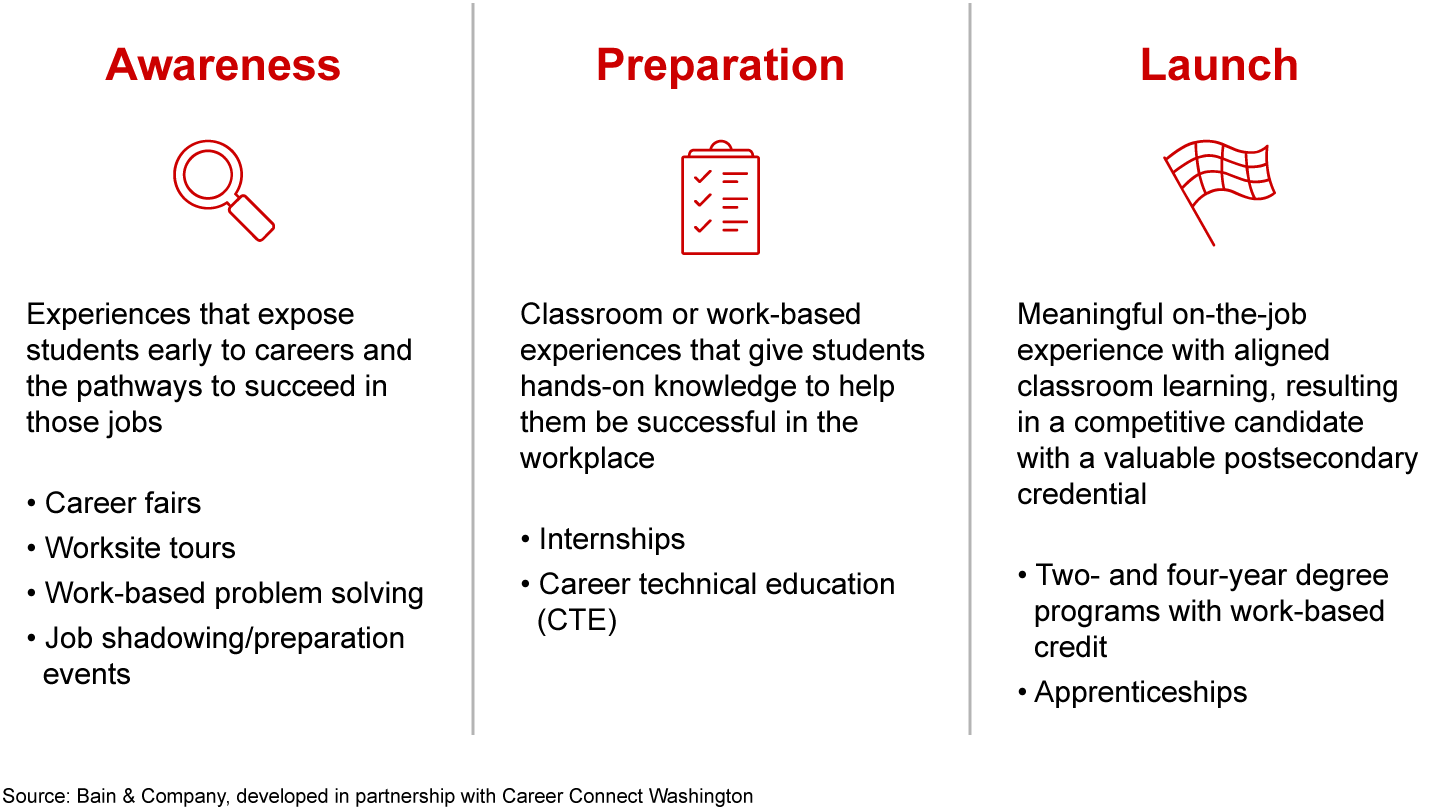
This isn’t a call for a return to the “A track/B track” world where some students are prepared for college and some are prepared for work. And it isn’t a “lesser” option. A well-designed career-connected learning program allows all students to choose the path that best suits their skills, interests, and learning style, and the balance of work and education may shift as paths diverge and reconnect over time.
The schools and postsecondary institutions that are making the shift find it transformational and energizing for students at all levels. By combining real-world experiences and classroom study, education becomes more relevant and engaging, which translates into more effective learning. By offering more choice, it opens opportunities that students may never have thought possible. By linking education to the job market and preparing students accordingly, it ensures that more young people, no matter what their background, can carve out a unique and productive place in an ever more complex economy. As Erin Ward Bibo, the former deputy chief for college and career education at DC Public Schools, puts it: “Great career-connected learning is what we should want for all of our kids. It’s hands on, it’s interdisciplinary, and it has real-world applicability. It’s just better than the typical siloed high school day, and kids respond to that.”
“Great career-connected learning is what we should want for all of our kids. It’s hands on, it’s interdisciplinary, and it has real-world applicability. It’s just better than the typical siloed high school day, and kids respond to that.”
Pulling this off requires employers and educators to engage with each other more productively. The opportunity is enormous; meeting it depends on building systems that accelerate progress and enable those employer/educator collaborations to happen at scale. Systems must be both market-driven and student-centered. Governments and system builders can help promote this balance, while helping to accelerate the growth of high-impact programs.
This will take time, commitment, and investment. But it isn’t a pipe dream. Promising statewide systems are already growing quickly to scale in places like Washington, Delaware, California, and Rhode Island. And the demand for change is substantial. As jobs get more complicated, requiring deeper training and more of it, the labor shortage has become critical for employers. The Covid-19 pandemic has opened the door to rethinking old ways of doing things and catalyzed innovation among educators and employers. The rising societal awareness of racial and economic inequality has also created enormous impetus for change.
Employers are highly motivated and aligned on the importance of creating stronger and more diverse talent pipelines. Educators are reenergized to build programs that prepare more students across the economic spectrum for a life that’s both prosperous and fulfilling. In Chapter 3, we’ll look at how these two key stakeholders can accelerate progress.

Chapter 3. A better model for career-connected learning
It’s not by accident that educators, employers, and policymakers have focused so intently on the value of a college degree.
High school graduates once could choose from a wide variety of jobs offering security and a family-sustaining wage. But the erosion of the manufacturing sector in the US and many other developed countries in the 1970s and 1980s eliminated many of those jobs and spurred a broad reevaluation of how best to prepare young people for the future.
In 1983, the US National Commission on Excellence in Education published a seminal paper called A Nation at Risk, arguing that the country’s once-mighty educational system was producing mediocre results and that students were ill-prepared for the future. K–12 systems had long invested in vocational programs aimed at steering noncollege-bound students into trades or solid, middle-class manufacturing jobs. But because new sectors like computer programming and finance depended on education beyond high school, school districts across the US shifted toward a college-preparatory focus and began measuring their success by how many kids went on to college.
As career preparation moved from secondary schools into the postsecondary realm, the federal government greased the skids by investing heavily in grants and lending programs like Pell Grants or Stafford and Perkins loans. But no system held colleges and universities accountable for job-placement results. No one tracked career outcomes for graduates, and the schools themselves didn’t view career success as their mission or responsibility. As we saw in Chapter 2, this resulted in a growing disconnect at both the secondary and the postsecondary level between what was being taught and what the job market required. Just as the US educational system in 1983 was increasingly out of step with the transition to a postindustrial economy, the educational systems in many countries in 2021 are struggling to adapt to the needs of a digital economy that’s evolving at the speed of light.
In Delaware, that much became abundantly clear in the wake of the global financial crisis of 2007–2009. Although employers in Wilmington and elsewhere around the state were aggressively looking for workers as the economy recovered, the state’s youth unemployment rate stood at 12% in 2014 (more than double the overall rate), while Black youth unemployment soared to 18%. More than 50% of Delaware high school students were deemed not “college or career ready” upon graduation.
The solution was to build a statewide career-connected learning system. Under former Governor Jack Markell, the state launched The Delaware Promise—a pledge that by 2025, 65% of the state’s students would have a college degree or a professional certificate valued by employers. The state’s employers, secondary and postsecondary educators, a variety of intermediaries, and state policymakers came together to create high-quality career pathways.
Notably, this was neither a single-minded crusade to get more kids into college nor a large-scale vocational program. It was a concerted effort to reimagine education as a more effective and more equitable launchpad to a prosperous career. As of 2021, more than 23,000 students (or over 50% of Delaware’s high school population) were enrolled in one of 24 Career Pathway programs. Around a quarter of all high school seniors and 30% of community college students had received on-the-job experience with a Delaware employer.
Delaware isn’t the only state embracing career-connected learning. Washington, Rhode Island, Indiana, and many others are building career-connected learning systems. They’re in various stages of development, and each is tailored to the unique circumstances in those states. The ones that are working, however, recognize that career-connected learning must be both student-centered and market-driven. This means that educators and employers must align their interests with the goal of enabling more young people to get and succeed in fulfilling careers. The career pathways need to make sense for both the students and their employers.
This isn’t easy. Working together to build an effective career-connected learning system requires a significant shift in mindset and priorities among secondary schools, postsecondary institutions, and businesses.
- For educators, it means elevating career outcomes so they become a central component of the mission. It requires aligning educational programs, curriculum, delivery, and credentials with that career focus.
- For employers, it means proactively investing in the workforce they need rather than waiting and hoping the educational system will deliver the right candidates. Partnering with educators to create meaningful career pathways requires resources and commitment. But the payback is access to a deeper, more diverse pool of talent armed with 21st-century skills.
In our extensive work with high schools, colleges, and businesses, we’ve seen what’s working as educators and employers come together to create coherent, meaningful pathways for students. The prerequisites are a bold ambition and a willingness to change, which can often be the biggest hurdle of all. But for those willing to embrace the challenge, educators and businesses are increasingly taking these concepts from the whiteboard into the real world and making extraordinary progress.
Educators: Elevate career outcomes
It’s increasingly clear to those engaged in education that students (and their parents) are getting fed up. While there’s a general understanding that a better life requires education beyond high school, the options are increasingly disappointing—especially in a digital economy that demands an ever-evolving set of skills from its workers. In the US, for example, college enrollment has been trending downward over the past decade, declining by 11% from 2010 to 2019. This decline has only worsened during Covid-19, with fall 2021 enrollment down another 6% from the fall of 2019.
Leaders at colleges and universities are hardly blind to these market forces. Most realize they need to adapt and improve the value proposition of their institutions if they want to stay relevant. But institutional reluctance to change can be a major impediment. Too often, traditional academic subjects are viewed as “education” and career-oriented programs as “training.” As the executive director of one career-oriented program puts it: “I am often met with arms crossed from the English department. There is real pushback from liberal arts faculty that preparing students for a career is ‘not our job’ and the real power often lies in the faculty senate. We still have a long row to hoe.”
Forward-thinking colleges and universities look at it differently. They recognize that liberal arts and career preparation don’t have to be mutually exclusive. They’ve concluded that career-oriented learning isn’t beyond their mission and, in fact, can enhance their value proposition to students—even at the tweediest of colleges. A good example is Ohio’s Denison University. Located on a leafy, 2,300-student campus a half-hour’s drive from Columbus, Denison ranks among the top liberal arts colleges in America, according to the Wall Street Journal and US News & World Report. Its 9:1 student-faculty ratio and strong reputation in the Midwest have allowed it to thrive for 190 years. Yet, when Adam Weinberg took over as Denison’s president in 2013, application growth had flattened and families were raising questions about the value of an expensive private education that required most families to take on some debt. As Weinberg saw it, Denison had a choice: It could start focusing on student career outcomes or risk losing students.
Weinberg didn’t try to separate career building from a firm grounding in the liberal arts. On the contrary, he believed learning how to think critically feeds the kind of curiosity, imagination, creativity, and social and emotional intelligence that employers value. But he also recognized that Denison needed to do more. The university launched a series of majors that weave together courses and experiential opportunities in areas like data analytics, global commerce, and global health. Denison also created three career-oriented centers covering career coaching, design thinking and entrepreneurship, and support for students who want to pursue academic careers. And it’s continuing to build. In the fall of 2021, Denison launched Denison Edge in downtown Columbus, linking the semirural campus with the nearby city. There students can participate in cutting-edge programs in marketing, finance, management, sales, human resources, and business analysis. They can supplement their Denison education with professional certifications and tap the expertise of business and industry leaders.
The results have been impressive. Outcome surveys show that 96% of recent Denison alumni are working in their desired field or position. And the new career emphasis has become a big draw among students. Since 2013, applications are up 99%, while early applications have soared more than 300%. The demand has been strong enough that Denison had to become more selective. Its acceptance rate has dropped to 28% from 51% seven years ago.
Denison proves that a focus on career outcomes can be transformative for a small liberal arts college. But for career-connected learning to provide the most opportunity to the widest range of students, it will have to take root more broadly, starting in high school and continuing seamlessly into postsecondary education. It’s especially critical that state-funded postsecondary systems, which serve the most students with the greatest need, embrace the challenge of preparing young people for the jobs of the future.
From our extensive work in education, we see three foundational elements to elevating career outcomes. First, K–12 and higher education providers need to focus on good jobs, not just any jobs. Second, they should build a “study-and-work” approach, with an emphasis on providing work-based learning opportunities and the wraparound supports that students need to launch into careers. Finally, K–12 and postsecondary providers must work together to make educational experiences seamless and transferable, to create clear pathways to valuable skills and credentials.
Focus on good jobs, not just any jobs
While this seems obvious, few educational institutions have a rigorous process in place to understand which industries are the most promising in their region and where they should aim their investments in career development. At a minimum, a “good” job is one that pays a family-sustaining wage and has limited vulnerability to automation and other technological displacement. But educators can, and should, aim higher by working with employers and experts on labor markets to focus on high-growth industries and careers. The digital transformation sweeping global markets means more and more companies are hungry for workers with specialized skills and capabilities. Using data and relevant expertise to understand where the opportunity is should be the first step in designing high-value career pathways.
Consider how this worked at a large university system that recently reevaluated its associate of applied science programs. An AAS is a professionally focused two-year degree that prepares students for a career in a given industry or profession. Unlike some associate’s degrees, it isn’t exclusively intended as a springboard to a bachelor’s program or further education. It’s designed and marketed to students as a way to prepare for a job with a two-year investment.
This system had many programs in areas ranging from nursing and computer programming to fashion marketing. But when it began to evaluate whether these programs were doing what they promised to do—prepare students to obtain and succeed in good jobs in locally relevant industries—they clearly were falling short in many areas. Too many programs focused on jobs that either wouldn’t hire someone with an AAS or that didn’t pay a living wage. Others focused on jobs that were in decline, with little demand from local employers. Still others did a poor job of preparing students for real-world success because they focused insufficiently on critical skills, relied on outdated content, or lacked relevant work experience.
A close analysis of career outcomes data showed how these shortcomings stunted performance. It found that 42% of students withdrew before completing their program, and 53% transferred to another program or continued their education after graduating, not necessarily an undesirable outcome. However, of the 5% of students who graduated and entered the workforce, only 1 in 5 (or 1% of the original group) had a job paying a living wage within a year—an especially distressing result given that a stated aim of AAS programs is to propel students into stable, family-sustaining jobs (see Figure 9).

This insight into career outcomes led to some soul-searching. “We have programs in fields that don’t lead to jobs or where the only available jobs are very low paying,” one college president says. “Should those programs continue?”
But it was also galvanizing. University leaders rolled up their sleeves and committed themselves to figuring out how they could do better by their students. This started with a three-question assessment of each AAS program:
- Is the program aligned with employer needs and targeting jobs that are accessible, attractive, and unlikely to be displaced?
- Is there enough demand among our students to justify the investment?
- What are student outcomes (graduation rate, employment rate, salary) and can we improve them?
A rigorous, data-driven appraisal led to a clear hypothesis about which AAS programs to keep, which to improve, which to convert to associate in arts or associate in science degrees, and which to get rid of entirely. This triaging meant that there would be more resources to sharpen the remaining programs to be more effective, targeted, and aligned with local employers.
“Every discipline has to have employers willing to hire. Not just talk, but hire. Getting there means we need to have employer partners—locally or nationally—that are not just informing the curriculum, but doing so in a way that makes them willing to hire graduates.”
Today, more than ever, many jobs and industries have requirements that are highly specific, making it essential to work with employers to devise curricula. Programmers, IT specialists, healthcare technicians, or advanced machinery operators all need specific skill sets to succeed in their industries, and those requirements can change frequently. Schools need to develop partnerships with employers to ensure that coursework is relevant and up-to-date. Close collaboration between schools and businesses can be a win-win for students and employers alike. As Angie Kamath, dean of the School of Professional Studies at New York University, explains, “Every discipline has to have employers willing to hire. Not just talk, but hire. Getting there means we need to have employer partners—locally or nationally—that are not just informing the curriculum, but doing so in a way that makes them willing to hire graduates.”
Build a “study-and-work” approach
The way schools deliver career-aligned content matters, too. For many forms of career-based education, classroom study needs to be augmented with actual work-based experiences. It’s no secret that most people learn better by doing. Real-time feedback from an experienced supervisor can be much more powerful than sitting in a classroom listening. That’s why doctors, nurses, teachers, architects, and lawyers all spend a significant portion of their education in the field, learning from more experienced practitioners.
We see exciting examples of this type of learning in high schools and on college campuses across the country. Consider the Full-Stack Developer Career Launch program created in Washington State by T-Mobile, Edmonds College, and the Edmonds School District high schools (see Figure 10).
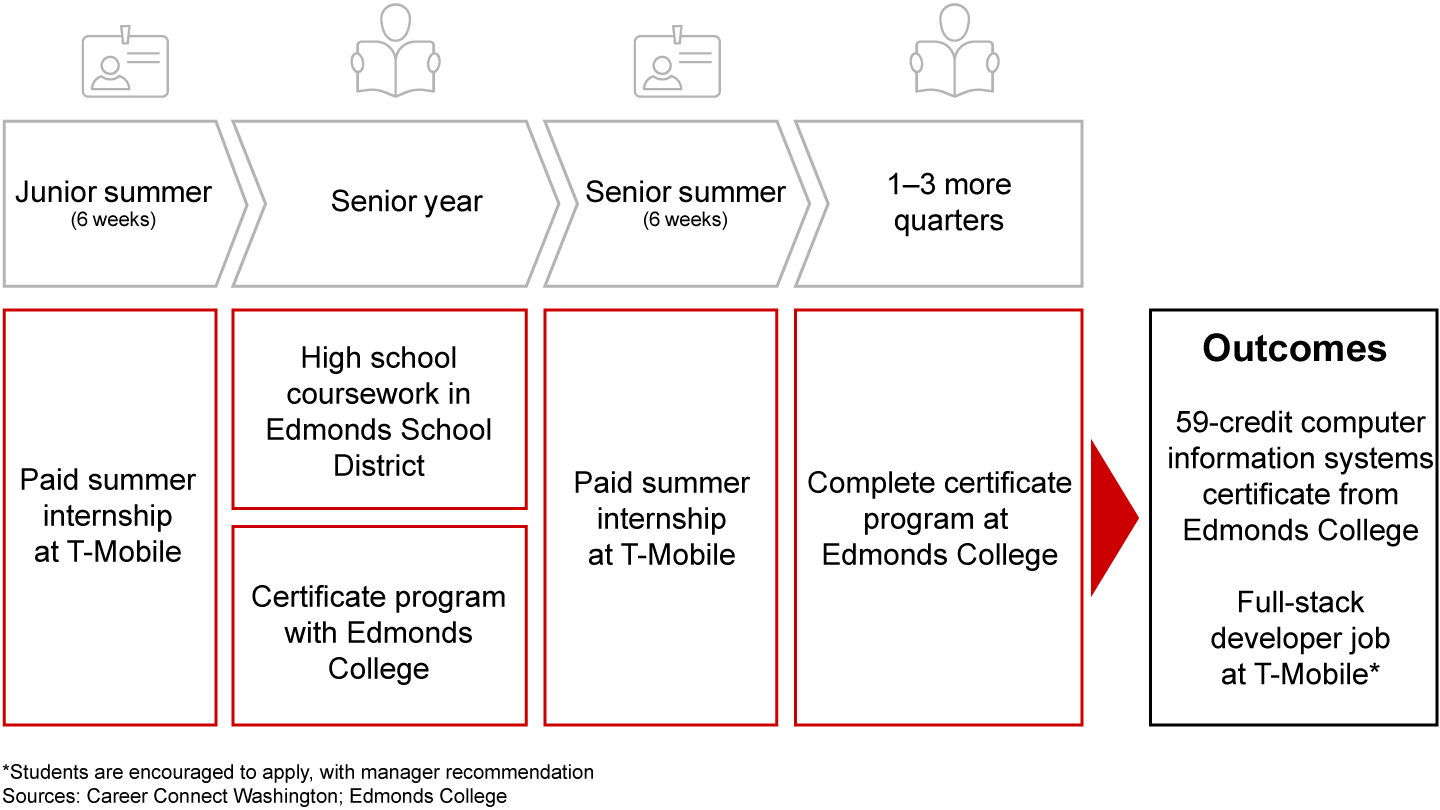
High school students kick off the T-Mobile program with paid summer internships after their junior year. As seniors, they take dual-enrollment college classes working toward a 59-credit certificate in computer information systems from Edmonds College. This includes both highly specific coding programs and foundational education in areas like human relations. Graduating seniors then take another paid summer internship, followed by the option to finish the certificate program as a full-time student. All in all, students participate in around 480 hours of hands-on internship time and 885 hours of classroom time. When it’s over, T-Mobile encourages students to apply for full-stack developer positions, which are junior engineer jobs that have traditionally been filled by employees with a bachelor’s degree.
Rhode Island education leaders have kicked off a statewide effort to expand work-based learning (WBL), aiming to better prepare students for the workforce of the future. Programs coordinated through the PrepareRI partnership of state agencies, educators, nonprofits, and employers increasingly combine in-classroom learning with hands-on work experiences. PrepareRI’s goal is to have all high school graduates participate in work-based learning. During the 2019–2020 school year, more than 1,900 Rhode Island high school students participated in a state-run WBL program—nearly all of them paid—at 74 employer sites, in addition to other district-driven WBL opportunities. These included full-time, paid summer internships with local employers like Citizens Bank, Amgen, Hasbro, and CVS. To increase scale while incorporating work-based learning more seamlessly into the classroom, 10 high schools are piloting a computer science course that pairs students with an industry mentor for an 80-hour work-based project in addition to coursework.
“Work-based learning can make classroom learning more engaging,” says Spencer Sherman, chief for innovation for the Rhode Island Department of Education. “It is the best answer to students asking, ‘When will I ever use this?’ and it is essential to set students up to succeed in their future careers.”
“Work-based learning can make classroom learning more engaging. It is the best answer to students asking, ‘When will I ever use this?’ and it is essential to set students up to succeed in their future careers.”
To give all students opportunities to get and succeed in good jobs, educators need to design these programs to ensure broad and equal access. Without an intentional commitment to equity, these opportunities tend to go to the kids who are already best positioned to succeed.
One higher education leader explained how this played out at a large university where this person used to work. To choose the best candidates to put in front of employers, the career services department set up a long list of requirements (mock interviews, strict résumé guidelines, etc.) that students needed to complete successfully before being allowed to engage with employers. The problem was that these hurdles unintentionally favored kids who could ask parents or professional networks for help. Students from low-income backgrounds who didn’t have those advantages were less likely to clear the hurdles and get chosen for job interviews. “Despite positive intentions,” the leader says, “career counseling services often end up helping the 30% of students who don’t really need the help.”
Recognizing that policies like this can entrench inequities, a growing number of colleges and universities are investing in resources to break down these barriers. For example, several institutions, including San José State University and Rutgers University–Newark, have partnered with Braven, a nonprofit that complements the work of career services and offers first-generation college students and students from low-income backgrounds a semester-long, credit-bearing “accelerator course” that seeks to level the playing field for career readiness. The program trains students how to create a résumé and write a cover letter. It helps them build leadership, problem-solving, and teamwork skills. It also offers access to a valuable network of peers and professionals. As Braven founder Aimée Eubanks Davis says of these university partners: “These forward-thinking educators have realized that a college degree alone is not enough to guarantee workforce success for all students, especially those from underserved backgrounds.”
“These forward-thinking educators have realized that a college degree alone is not enough to guarantee workforce success for all students, especially those from underserved backgrounds.”
Create clear pathways to valuable skills and credentials
In a well-designed career-connected learning system, work-based learning experiences begin in high school and continue into postsecondary education. For students to progress seamlessly, however, disparate programs and experiences need to connect and stack, meaning they build on each other clearly and efficiently. These linked Career Launch experiences—wherever they take place—must lead to skills and credentials that are recognized and valued by employers in an attractive industry.
To create clear and connected pathways, different education entities have to coordinate and cooperate. At the large public university system we discussed earlier, students often transferred from two-year AAS programs into one of the other 20-plus colleges and universities in the system. Frustratingly, transferring their earned credits was complex, inconsistent, and often infeasible for many students. Transfer students spent, on average, three to four semesters accumulating a meaningful number of AAS credits (30 to 60). But when many tried to transfer them to another degree or credential program—even in a related field—most of those credits weren’t applicable, leaving students with little to show for their time and tuition spent. As one administrator explains: “An AAS is a terminal degree, so there are no universal policies about credits transferring, and they often do not. This can be really confusing for students to navigate, especially since [the university] encourages two-year students to transfer, including AAS students.”
In Delaware, by contrast, the pathways are clearly articulated. After starting in high school with coursework and hands-on learning, the system offers students a choice. They can continue on to further education, secure in the knowledge that their skills and credits will help accelerate progress toward a degree, or they can earn an industry-recognized credential and take their skills straight to work.
Delaware’s Allied Health pathway is a good example (see Figure 11). Students who complete required classes and work-based learning at the high school level can then earn a nationally recognized NCHSE National Health Science Certificate. They can then pursue a college degree by applying their credits toward majors such as health sciences. What’s important is that students are in charge of their options. These pathways can build toward various degrees or credentials, and ultimately a promising career as a physician assistant or doctor, with the option to stop at several points along the way to work and earn a living.
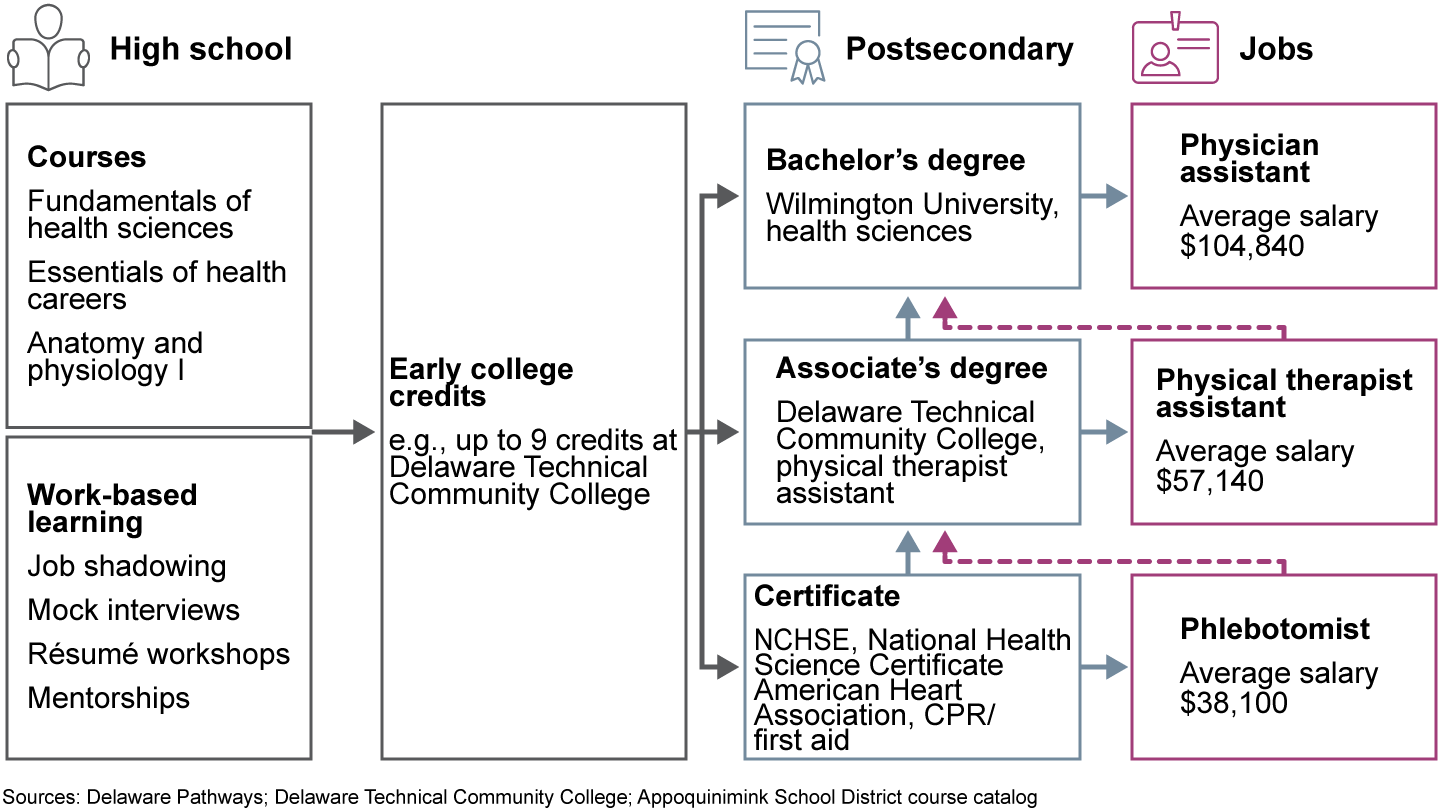
Best-in-class pathways like this one need to result in a credential that has true value in the market, meaning that employers are actually hiring candidates with those certificates or degrees for good jobs. Labor-market and hiring data can help institutions understand what credentials and skills are in demand with local employers.
In Chapter 4, we’ll discuss how system builders and governments can similarly use labor-market data to focus the system as a whole on the industries and occupations that truly matter. But for individual institutions, the right career outcomes data can help light a fire and catalyze change. Being confronted with this data was eye-opening for the public university system with whom we worked. The insights that arose were invaluable for decision makers and led to important conversations and a commitment to change. Without a window into student career outcomes, this never would have happened. Outcomes data can also be used regularly to assess the programs’ impact and encourage continuous improvement.
Employers: Invest in the workforce you need
In 2019, the US Business Roundtable famously redefined the purpose of the corporation by declaring that CEOs need to run their organizations to serve all stakeholders, not just shareholders. It was a recognition that a company’s responsibility extends as much to customers, employees, suppliers, and communities as it does to investors. This was an altruistic declaration, but also a practical one. “The American dream is alive, but fraying,” said JP Morgan Chase’s Jamie Dimon, then chairman of the Business Roundtable. “Major employers are investing in their workers and communities because they know it is the only way to be successful over the long term.”
Implicit in this shift is a recognition that employers have traditionally been consumers more than developers of talent. They expect educators to deliver ready-to-go employees and then are disappointed when that doesn’t happen. The growing number of CEOs who have embraced career-connected learning see it as a competitive necessity. They’re apt to say that more countries should follow the lead of Switzerland, where approximately 40% of employers give jobs to high school-aged apprentices who spend time in a mix of classroom and work-based learning over a two- to four-year program. Swiss companies don’t do this because they’re required to do so, but because it’s a smart way to develop a high-quality talent pipeline. It’s a change in mindset from hiring the workforce they want, to proactively developing the workforce they need.
The companies successfully negotiating this transition focus on three important shifts in how they find and develop talent. It starts with skills-first hiring, in which companies prioritize the skills required for a particular job, not just degrees or other résumé items, in making hiring and promotion decisions. Second, companies need to invest in work-based learning opportunities that provide young people with meaningful work linked to in-class study programs. Finally, employers need to develop careers, not just jobs, building pathways and support to ensure the people they hire can take the next step and progress in their careers.
Embrace skills-first hiring
Our analysis of US job postings (sourced from Emsi Burning Glass, 2021) found that around 60% of postings for good jobs—those that pay above living wage and have limited vulnerability to automation—list a four-year degree or above as a requirement. However, when we dug in deeper and examined similar postings, we found that only 1 in 4 good jobs should necessitate a bachelor’s degree.
If you ask employers why this is, the answer is usually pretty simple: habit. Employers have long required a bachelor’s degree as a screening mechanism, seeing it as a seal of approval signifying “persistent,” “hardworking,” and “smart.” Yet with college graduation rates as low as they are—often for reasons that have nothing to do with persistence or capability—this presents a real problem for companies hoping to tap a richer pool of talent. Consider that according to the US Census, only 28% and 21% of US Black and Hispanic adults, respectively, have a bachelor’s degree or higher, putting the great majority of these populations out of the running for most good jobs.
Slowly but surely, however, many companies are realizing that narrowing the talent pool in this way is counterproductive. Just because candidates have a college degree doesn’t mean they’re qualified to do the job. Insisting on a four-year degree takes the focus off what really matters: whether a job candidate possesses the skills, capabilities, and mindset to do the job effectively. Candidates can acquire and demonstrate these skills in various ways, including earning industry-valued credentials, participating in training programs, or accruing relevant work experience.
Second, it presents a lost opportunity. Focusing on skills widens the aperture to a broader and more diverse set of job candidates. This addresses two critical imperatives every CEO in America faces: the need to build a workforce that’s competitive and the need to build one that’s diverse and equitable. Says Nickle LaMoreaux, IBM’s chief human resources officer, “If you shut the door to talent because it doesn't come with a degree, you are really closing off your potential for success.”
Five years ago, 90% of the jobs at IBM required a bachelor’s degree. Today, only 50% do. The reason is that IBM has completely transformed its hiring and talent development practices as part of a broader effort to implement skills-first hiring. Like many companies in recent years, IBM has struggled to find skilled employees to keep up with the rapid changes in the digital economy. So IBM has changed how it evaluates talent, while creating a development pipeline steeped in career-connected learning (see Figure 12).
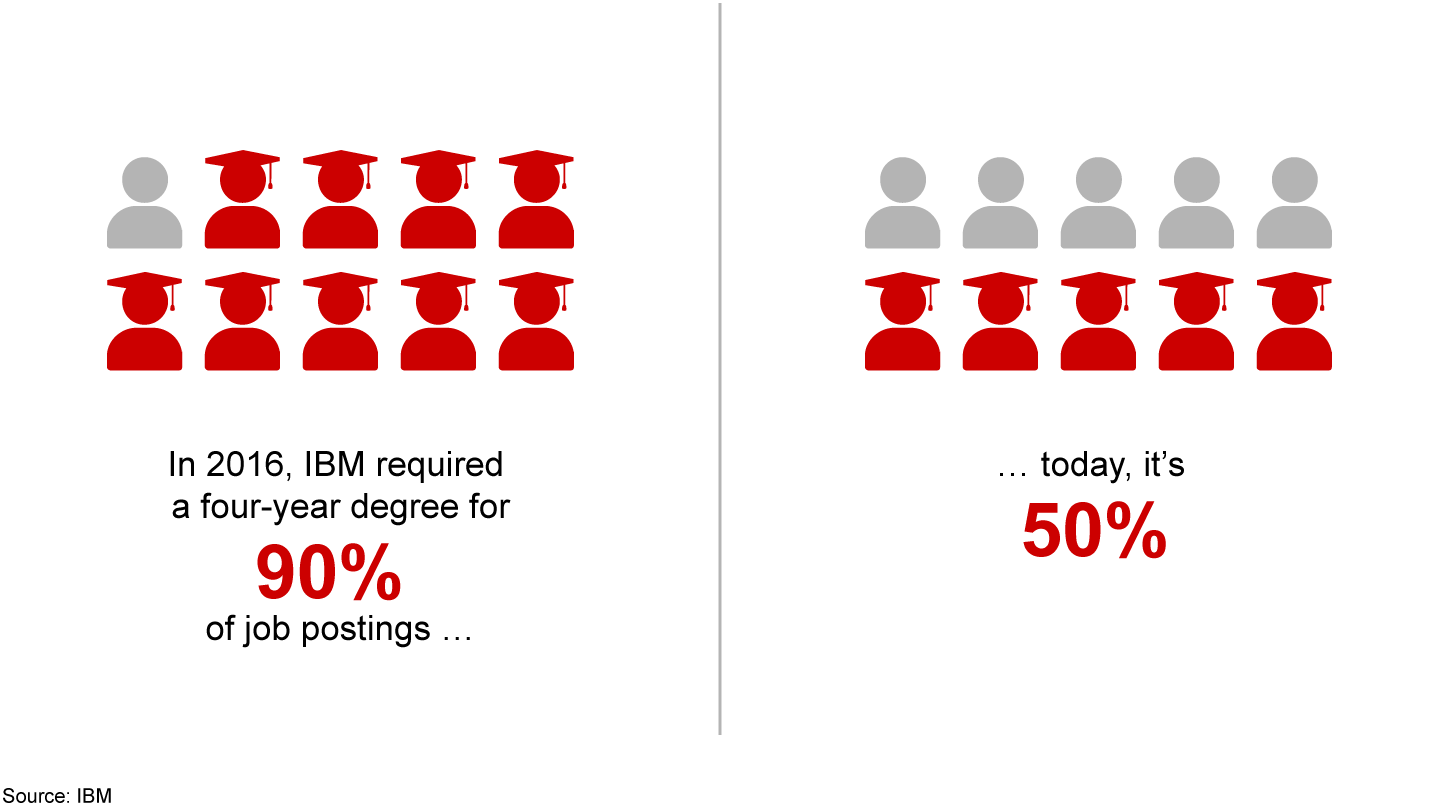
IBM now evaluates talent based on the specific skills required to do a job effectively. It’s deliberately agnostic about how those skills were acquired. A good example is a job IBM calls cyberthreat hunter. It entails ferreting out bad digital actors intending to harm IBM clients. The job originally required three to five years of experience in several highly specific areas such as cyberthreat intelligence, and a bachelor’s degree was preferred. The new job description focuses less on generic experience and more on specific skills, such as proficiency in various programming languages, the ability to develop hypotheses and perform investigations, the knowledge of computer network protocols, and expertise in using granular details about network flow to spot bad actors. The point of this specificity is to set a target. It shows what skills employees must have or acquire to fit the bill.
Reassessing job categories is really just the first step in a much broader transformation at IBM focused on creating more robust, targeted talent pipelines. As former IBM CEO Ginni Rometty notes, skills-first hiring involves much more than simply emphasizing skills. “This is a long-term journey,” she says. “It changes how you interview, how you manage, how you promote. In the end, everything changes. Because it’s not a job you are giving someone, it’s a career.”
Put the “work” into study-and-work
In the new IBM talent development system, that journey starts in high school and involves a commitment to building—rather than buying—talent. The company spends over $12 million each year on Pathways in Technology Early College High School (P-TECH) earn-and-learn opportunities. P-TECH exposes high school students to a variety of tech occupations, providing meaningful work experience and culminating in an associate’s degree in an in-demand technical field as well as industry-valued credentials. IBM also invests $30 million annually in its registered apprenticeship program, aiming to further develop pathways to family-sustaining careers.
Unfortunately, this isn’t as common as it should be. For the kinds of apprenticeship programs that steer more young people into well-paying jobs, Switzerland and Germany are the global leaders by far (see Figure 13). In the US, actively registered apprentices made up less than 1% of the US working-age population in 2020, and most were highly concentrated in skilled trade industries. Many apprenticeship programs also suffer from persistent racial and gender disparities. Women and people of color often face discriminatory recruitment practices and lower enrollment rates and end up in lower-wage occupations.

Both the scarcity and narrow focus of apprenticeships are curious given the measurable benefits these programs offer. Not only do they present an opportunity to focus training on the skills and workforce a company needs, but done right, they enhance retention, promote diversity, and often come with tax breaks. There’s no doubt that developing a strong program is an investment in time, money, and resources. But companies looking for scarce talent are increasingly finding ways to make the investment pay off.
A number of companies are joining forces to scale work-based experiences. The Chicago Apprentice Network founded by Aon, Accenture, and Zurich North America is a prime example (see Figure 14). Focused on recruiting companies to join the apprenticeship movement, the network gives employers the peer advice and support they need. Since 2017, the network has grown to more than 50 companies and hosted more than 1,000 apprentices, with plans to scale to 10,000 apprentices by 2030.
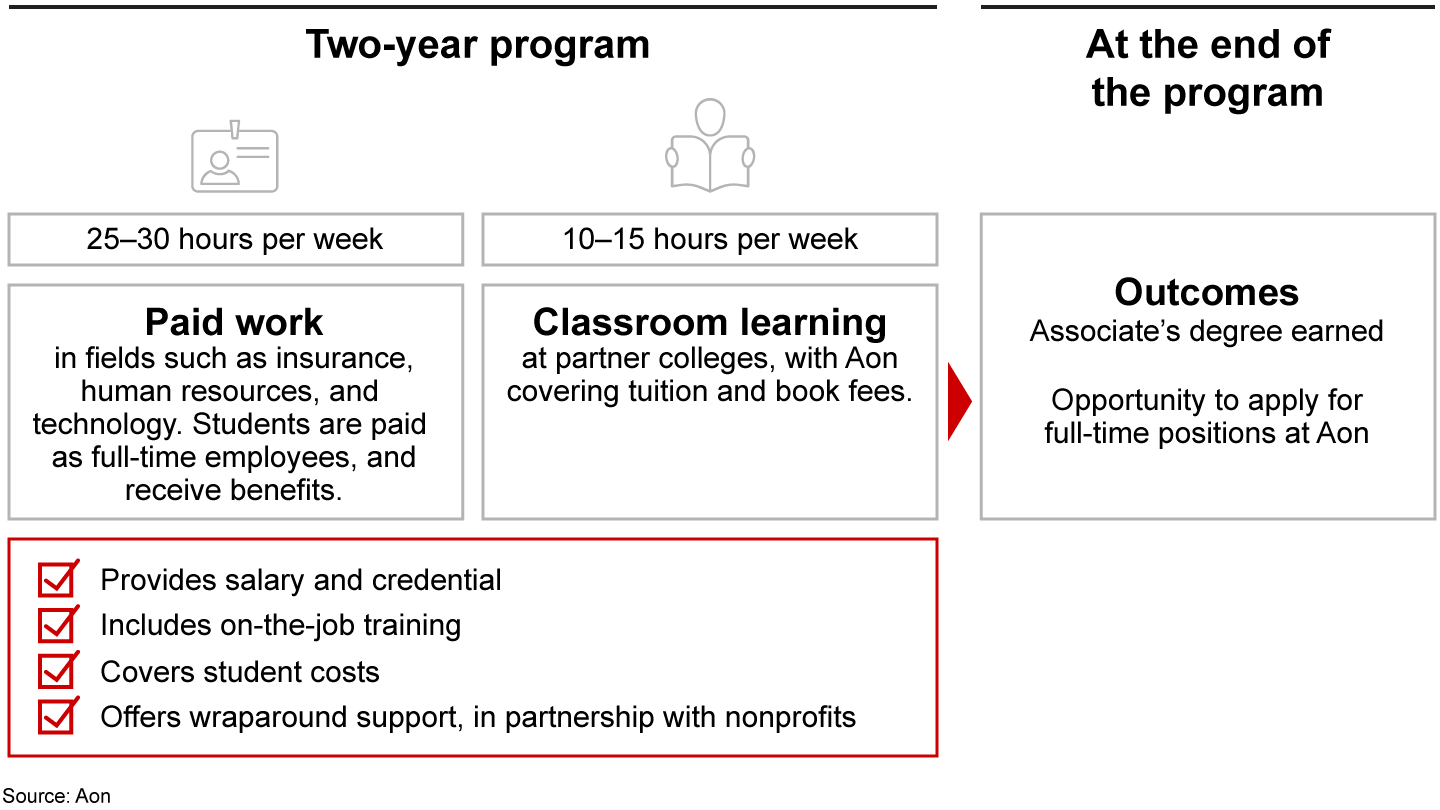
Aon, a multinational insurance company that moved its headquarters from Chicago to London in 2012, had successfully run an apprenticeship program in the UK for years. Faced with a growing skills gap in the US, it decided to do the same in Chicago. In 2017, Aon teamed up with fellow Chicago employers Accenture and Zurich North America to forge a career-connected learning ecosystem. It includes City Colleges of Chicago and College of Lake County, as well as One Million Degrees, a nonprofit that provides wraparound coaching support for the apprentices.
This framework provides the kind of study-and-work experiences that allow young people from all backgrounds to rise into well-paying positions without incurring the heavy cost of earning a four-year degree. Participants at Aon work 25 to 30 hours a week at the company and learn in the classroom 10 to 15 hours a week at a partner college, earning their AA by the end of the program. They’re considered full-time employees, with Aon covering salary, benefits, tuition, fees, and books. Roles span project management, technology, and data analysis and include both on-the-job training and coaching/mentorship support from One Million Degrees. When apprentices successfully complete the two-year program, they can apply for full-time positions.
Develop careers, not just jobs
Skills-first hiring and work-based learning broaden talent pipelines and increase access to good jobs for people who today may struggle to get a foot in the door. This, of course, is intentional; employers across industries have a clear need to create younger, more diverse workforces fluent in the digital technologies disrupting markets globally. Traditional talent pipelines aren’t doing the job. Career-connected learning can be the solution.
But to make the investment pay off, companies need to do something else. They have to ensure that the young people getting that first entry-level job then have a place to go, and there’s a pathway to growth and a career.
That starts with clearly delineating where that first job can lead and laying out the skills or credentials needed to get there. Then companies have to put systems and supports in place to ensure that young people in those jobs can successfully progress to the next one.
As part of IBM’s emphasis on training and upskilling, for instance, the company keeps lists of skills that are in demand and those that are waning so mentors and managers can use them in reviews. It developed a website called Your Learning, which LaMoreaux, the CHRO, called “a Netflix for learning.” It allows employees interested in a new role to dial up educational content from both IBM and external sources in conjunction with classroom training. “So if you want to be a certified cloud specialist, for instance, Your Learning gives you the roadmap you personally need to get there,” LaMoreaux told a Gallup interviewer.
In addition, IBM installed wraparound services including financial coaching, peer buddies, and professional coaches for new hires. It also retrained every hiring manager at IBM in how to interview with a focus on skills and a growth mindset, recognizing the embedded bias in favor of college graduates (see Figure 15).

Companies that get it right say new pathways have to be designed in partnership with the individuals whom employers are attempting to support. If CCL talent pipelines are doing their job, new employees will be different than from previous generations. They’ll probably be younger and from more diverse racial and socioeconomic backgrounds. What it takes for this new group to grow and thrive will be different; figuring out what works starts by listening to them. Investing in building this support and necessary changes requires commitment from the top.
Overcoming old habits and embracing new ones requires strong leadership. American Express, for instance, has been recredentialing job categories for years and works with nonprofit talent developer Year Up on apprenticeship programs to seed pipelines with talent from low-income groups. Monique Herena, the company’s chief colleague experience officer, says the impetus has to start in the C-suite. “Prioritizing skills over degrees requires a mindset shift and a corporate culture change,” she says. “Driving that change starts with leadership at the highest level; ongoing, visible leadership is critical.”
“Prioritizing skills over degrees requires a mindset shift and a corporate culture change. Driving that change starts with leadership at the highest level; ongoing, visible leadership is critical.”
Achieving career-connected learning at scale also requires collective leadership, not just individual CEOs pounding the table in isolation. Employers and educators have to align on a shared vision that they can work together to develop the workforce they need and help a broader and more diverse set of students acquire the skills they need. This is happening in many places but is nowhere near its full potential. Achieving breakthrough scale requires catalytic support from proactive government leaders and system-building intermediaries. In Chapter 4, we’ll look at how these important stakeholders can best accelerate success.

Chapter 4. Accelerating progress at scale
While the state or regional systems we discussed in Chapter 3 prove that career-connected learning can work at scale, these are the exceptions. The CCL efforts we see most often are small programs, the product of individual educational institutions and employers getting together to create opportunities for students. They tend to be on an inherently slow growth curve, often with unclear or limited impact on career outcomes.
Scaling career pathways beyond individual programs requires close coordination of entities that don’t naturally collaborate. While one-to-one relationships can be achieved through strong leadership, expanding programs to other companies and institutions can be complicated and time-consuming. This is especially true given the fragmentation of both education and employment. In the US, for example, there are more than 25,000 secondary schools, nearly 4,000 postsecondary institutions, an additional 2,000 nondegree institutions, countless bootcamps and training programs, and 6 million employers (see Figure 16).
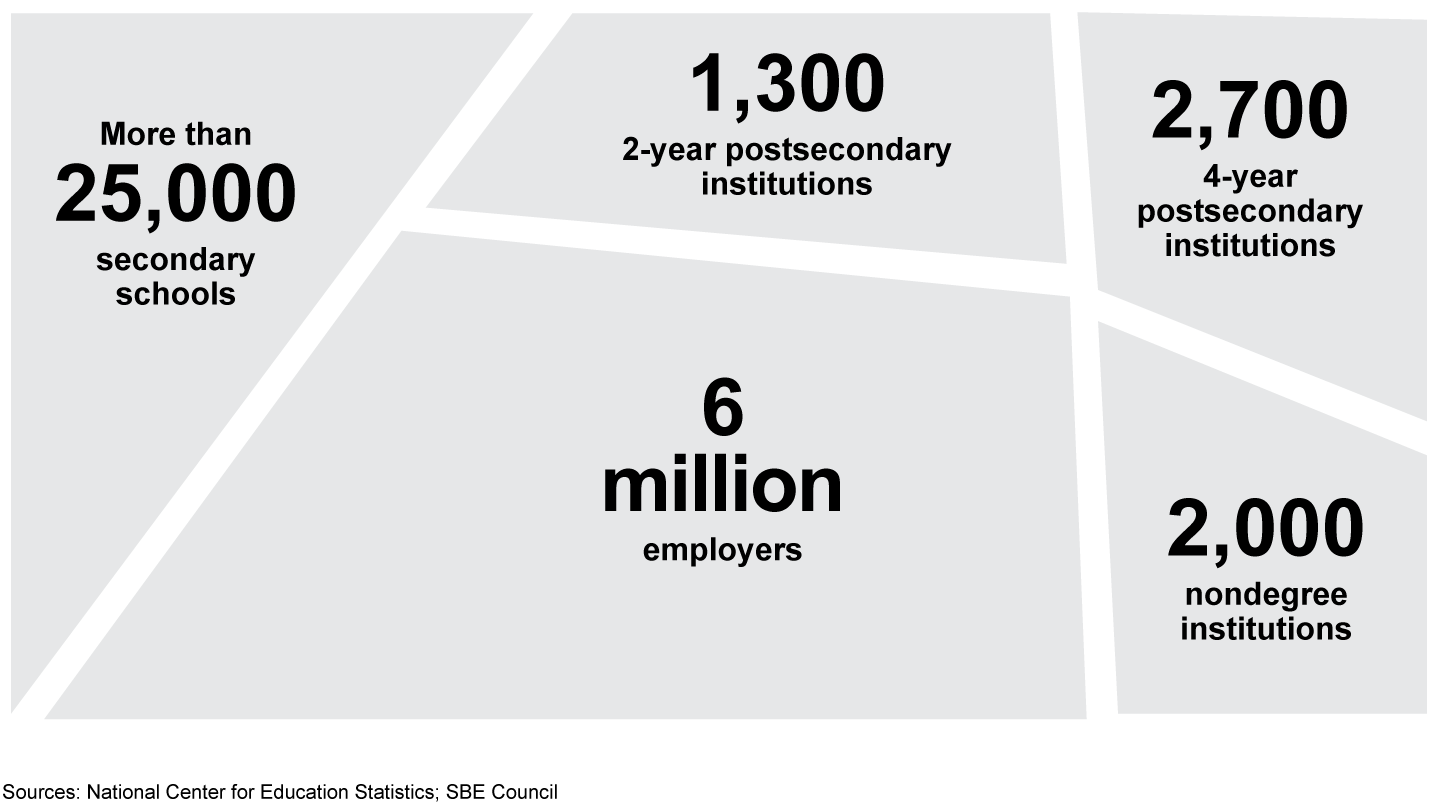
Without some sort of coordinating entity, the odds are small that schools and employers will find each other in large enough numbers to significantly improve youth employment or the broader economy. Market forces, meanwhile, aren’t enough to guarantee quality. The highest-impact programs don’t always rise to the top on their own. Without a clear set of recognized standards, even many well-intentioned programs may replicate persistent inequities that exist today.
The importance of government and intermediaries
Moving further and faster requires an accelerant. And that’s where state governments and system-building intermediaries can play a critical role. These entities can hasten progress by helping employers and educators navigate this highly fragmented ecosystem. They can promote and fund what works. They can hammer out the standards for what strong and equitable career pathways should look like and what they should achieve for both students and employers. They can help the best programs to scale.
Strong leadership from government has been critical to much of the success we’ve seen to date. But policymakers also benefit from partnering with system-building intermediaries, which are often funded by a combination of government money and philanthropy. The groups we’ve studied differ, but they share a common goal: ensuring that highly effective career-connected learning programs scale and combine into a system that benefits students and employers alike. They champion the idea that this happens not just by improving the high school experience, or by transforming postsecondary institutions, or by shifting employer hiring and training practices, but rather by doing all three of these things in concert.
A big part of this process is working together with educators and employers to make hard choices about where to direct resources, time, and energy. There’s no single formula for success, but strategies with the most impact tend to rest on a few key principles.
First, governments and system builders need to be market-driven, shining a bright light on the industries and occupations that matter most regionally. Second, they need to set a high bar for programs, insisting that they prepare students to get and succeed in good jobs and meet employer needs at scale. Then, they must build on what works, finding successful programs with the most promise, helping make them better, and then helping them replicate. A big part of this is insisting on financial scalability, making sure programs have a path to sustaining themselves. And it involves creating smart incentives for success that can generate momentum and spur on growth (see Figure 17).
Together, these principles give governments and system builders the best chance to create a high-impact and sustainable career-connected learning system at scale.
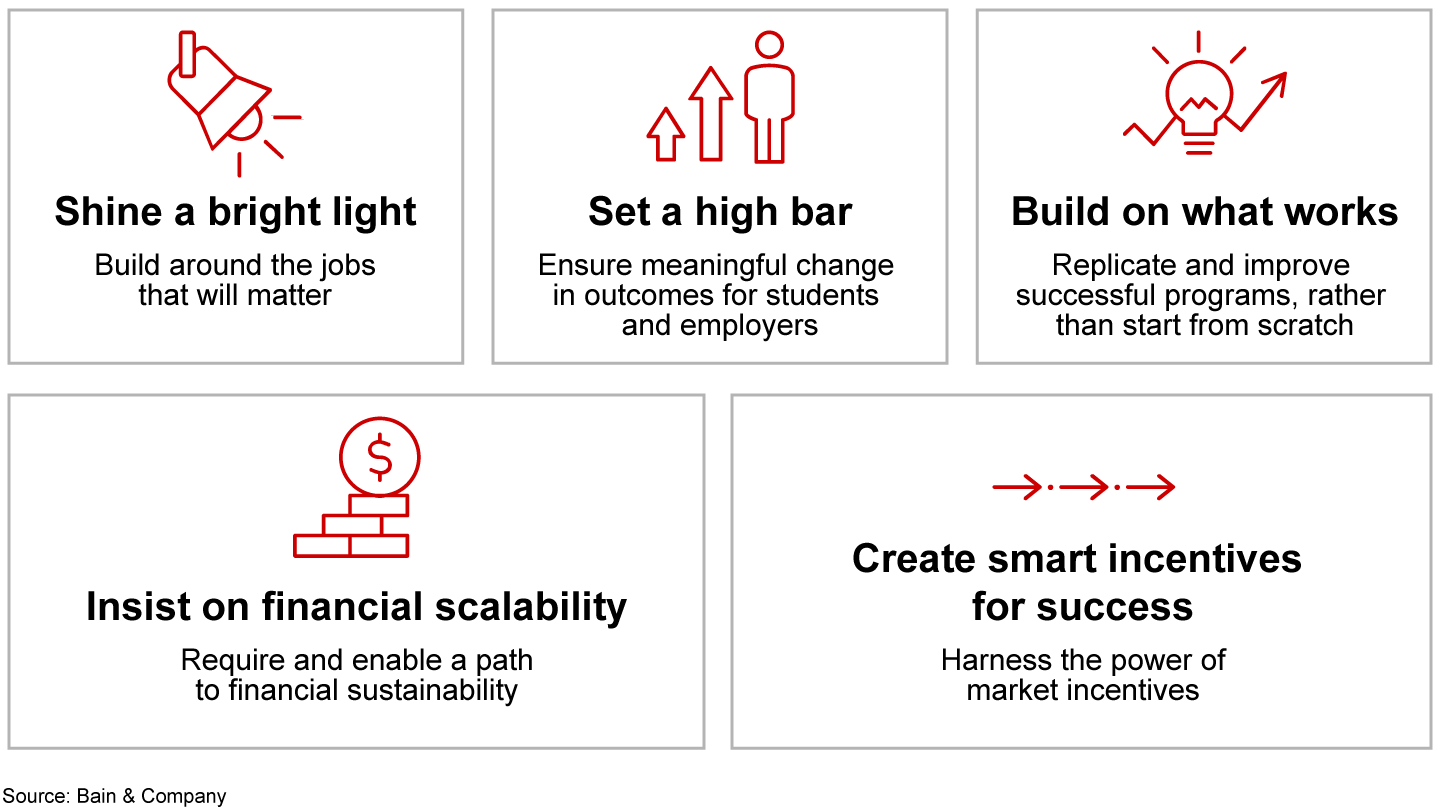
Shine a bright light
Governments and intermediaries can play a vital role in shining a bright light on the best opportunities—the occupations and industries in the local market that best align with both student and employer needs. Even the most progressive educational institutions struggle to stay abreast of changes in the labor market; for students, it’s even more difficult. Students need to understand which industries have jobs, what skills those jobs entail, and which credentials will best demonstrate proficiency. They’ll also need to find the highest-quality career preparation with the best prospects for success.
Governments and intermediaries can play a vital role in shining a bright light on the best opportunities. In 2014, Arkansas gubernatorial candidate Asa Hutchinson announced a plan for Arkansas to become a national leader in computer science. Arkansas had over 1,000 unfilled jobs in computer science. These are good jobs, with an average salary of over $70,000 (compared with the state average of just under $45,000). Yet given the small number of high school students in Arkansas then studying computer science, Hutchinson knew a talent gap was looming. Once elected, he embarked on a mission to make computer science training available to every student in Arkansas, which passed legislation in 2015 requiring that all high schools offer at least one high-level course in the field. The results were dramatic. Before the law passed, only around 1,000 Arkansas high school students were studying computer science. By 2021, the number of computer science students had climbed to over 12,500, including a big boost in female students (from 223 to nearly 4,000), and with Black students now proportional to the overall student population at roughly 20%. Every public high school in Arkansas now offers a course in computer science (compared with around 50% nationally), providing a robust set of opportunities for students and a new engine of growth for the state (see Figure 18).

California also focused its career-connected learning efforts on the sectors with the greatest economic potential for students. As Van Ton-Quinlivan, former executive vice chancellor of California Community Colleges, says: “We followed the call of the labor market in designing workforce development opportunities.” This took shape as a statewide initiative called the Strong Workforce Program, which launched in 2016 and provides $248 million in ongoing state funding to help community colleges expand career education programs and improve workforce outcomes. The effort began by focusing on 10 industries vital to the state’s economy, including advanced manufacturing, life sciences and biotech, information and communication technologies, and healthcare. The program encouraged coordination by grouping all community colleges in the state into seven regional consortia, which then used labor-market data to further identify the industries most relevant to their region. Community colleges, alongside local workforce development boards, employers, and education agencies, then mobilized to create educational pathways targeting those industry sectors. They didn’t stop there. They also created a website called Salary Surfer to show median annual incomes for the most popular community college programs in the state. Students can use the site to choose a degree program, using data from other graduates to make better choices (see Figure 19).
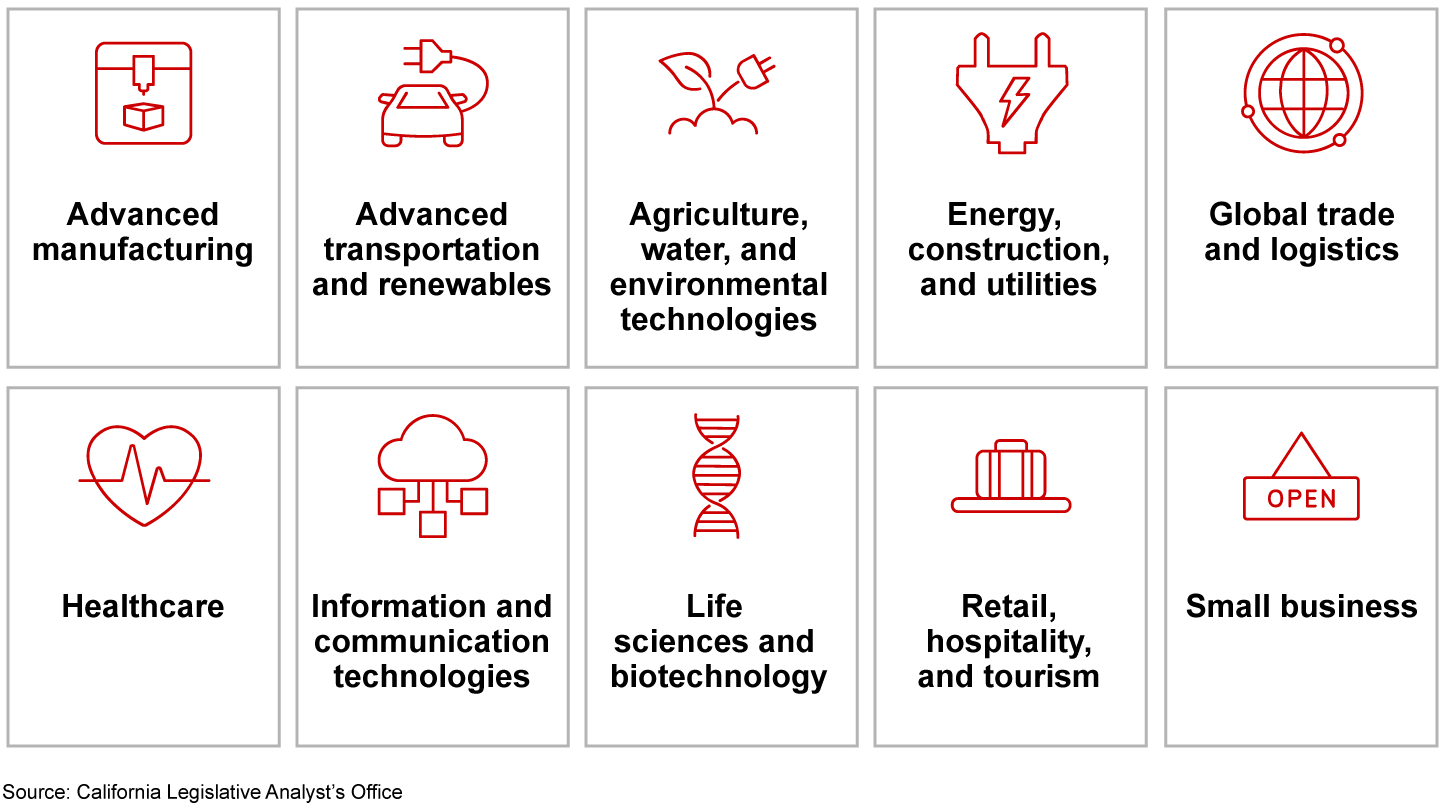
Set a high bar
Given their vantage point across the system, state leaders and intermediaries are in a unique position to help shape what a transformational career-connected learning system looks like. They’re also best positioned to forge consensus on the quality standards educators and employers must achieve as they join others in building pathways. The most successful systems set a very high bar.
There are lots of CCL programs and activities out there, including countless job-shadowing experiences and career fairs. But to maximize impact, governments and system builders define success as programs that create a step change for both students and employers. The programs don’t merely touch the lives of students; they fundamentally change them. They don’t just engage employers with a nice-to-have HR experiment, but fill their pipelines with highly skilled workers who will thrive in those roles. Ultimately, these two flavors of outcome add up to the ultimate goal: young people from across the economic spectrum contributing to and benefiting from a flourishing, dynamic economy.
That was the state of Washington’s goal in 2018, when school districts, postsecondary institutions, labor organizations, and major employers such as Boeing, Amazon, and Kaiser Permanente came together behind a bold ambition: 60% of Washington’s class of 2030 would be able to choose a robust career-connected learning experience to propel them from high school to career and college-level learning. A core part of the strategy was setting and maintaining a clear definition of success. That started with the basics. Career Launch programs had to align meaningful work experience with classroom learning, leading to an industry-valued credential. Providers also had to demonstrate that their programs met specific, rigorous requirements, including at least 45 credits of college-level study and paid work experience, as well as clear guardrails to ensure equity. Career Launch endorsements send valuable signals to both students and employers about the quality of programs, analogous to the seal of approval conferred by LEED building certification or the organic food designation (see Figure 20).
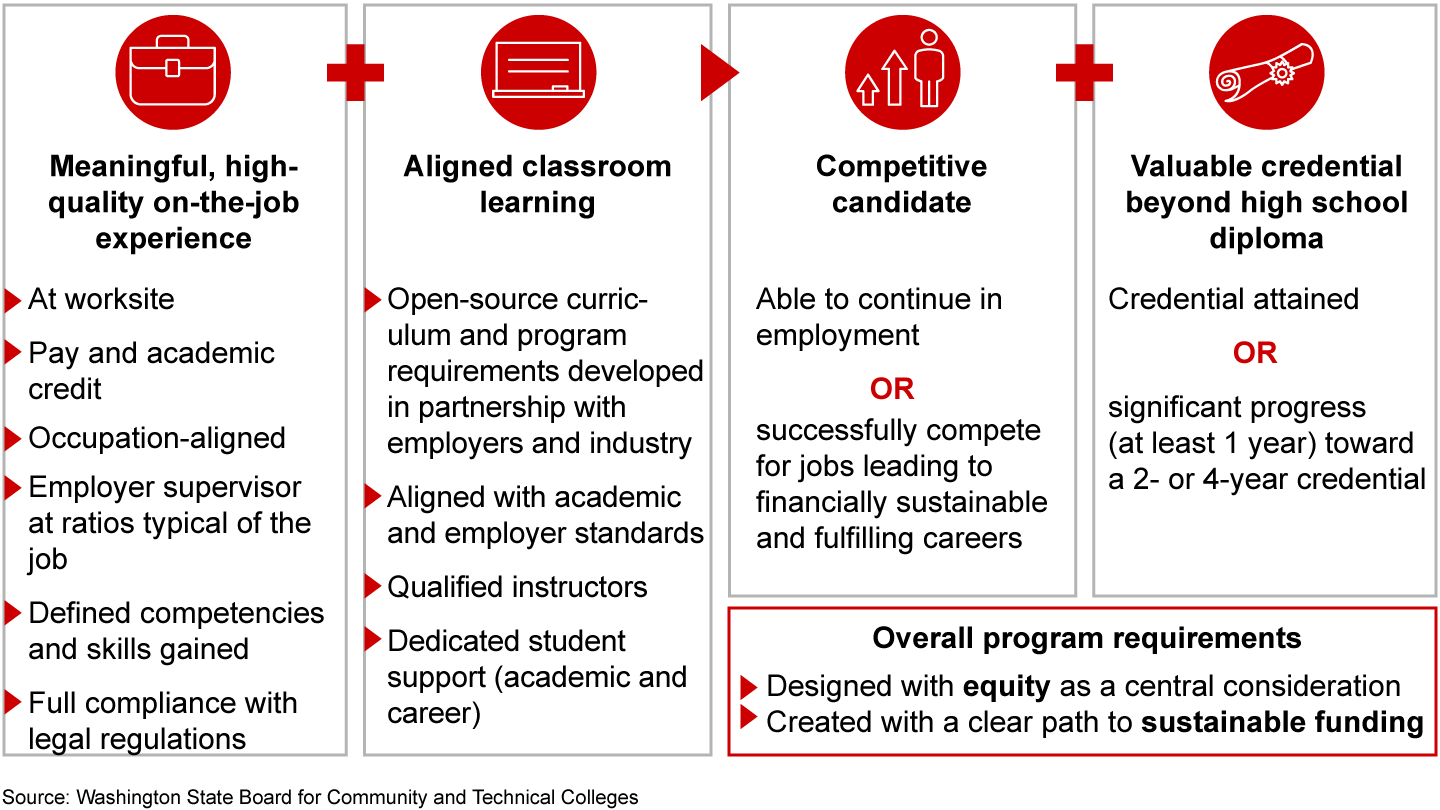
Employers’ needs and the opportunities for students vary significantly from market to market. But there are a few essential elements that any system should aim for. In September 2021, a group of community college presidents and other education leaders in the US sent an open letter to Congress seeking support for job-focused education opportunities. Their model defined high-quality programs as those that culminate in valuable credentials, offer credits that are stackable, provide meaningful labor-market information, offer wraparound support, and include work-based learning. These are all key components. But governments and system builders also need to ensure that career-connected learning systems are designed with expanding access as a central consideration.
This means prioritizing programs that focus on creating opportunities for all students, not just those who are already set up to succeed. For employers to access a broader talent pool, and students from all backgrounds to benefit from CCL opportunities, systems should focus on scaling programs that provide proven pathways to success for all students. A student’s socioeconomic or racial background shouldn’t be predictive of enrollment, completion rates, or workforce outcomes. Beyond the critical fairness imperative, there’s a market need here. Only a portfolio of programs that collectively works for all students will open up a vast talent pool that’s currently going untapped.
For both systems and the programs they help scale, this entails thoughtful design choices on how they’ll attract students and families and ensure student success. Washington, for example, requires Career Launch applications to demonstrate how programs will recruit and support students from underserved backgrounds. Rhode Island ensures that apprenticeship programs recruit students who have been historically underrepresented in college and work-based learning programs. Programs also are expected to proactively reduce traditional barriers to student participation by, for example, guaranteeing transportation access or providing additional mentorship and coaching.
Build on what works
Building an effective career-connected learning system inevitably pushes governments and system builders to make smart choices about how they allocate limited time and resources. System builders tackle this by designing programs from scratch, helping to expand existing programs, or some combination of the two.
In places where career-connected learning programs don’t yet exist, designing from scratch is the only option. But in our experience, system builders are far more successful if they focus their limited time and resources on finding and scaling what’s already working. That has both short- and longer-term benefits. Successful programs already have momentum, and helping them scale can have immediate and far-reaching impact. As others see what works over time, it inspires spin-offs from ambitious employers and educators looking to replicate the success of those who went before.
Career Connect Washington, for instance, explicitly set out to build on the state’s wealth of existing programs. Some programs could expand, some could be widely replicated, others could be pushed to improve and then expand. What it didn’t do was start with a blank sheet of paper. “We didn't want to reinvent the wheel,” says Maud Daudon, executive leader of Career Connect Washington, “Rather, we wanted to make sure the programs we supported were high-quality, impactful programs with the potential to either grow or replicate.” In just a few years, this approach has helped Washington achieve meaningful scale with high-impact programs. Endorsed Career Launch programs enrolled nearly 13,000 students between the summer of 2020 and the following spring. Washington is still closer to the starting line than the finish, but that’s a significant number in a state with approximately 80,000 students per grade level.
“We didn’t want to reinvent the wheel. Rather, we wanted to make sure the programs we supported were high-quality, impactful programs with the potential to either grow or replicate.”
Choosing the programs starts with assessing the impact on students and businesses. But the ability to scale that impact is also essential. As Robert Schwartz, senior adviser to the Harvard Project on Workforce and cofounder of the Pathways to Prosperity Network, says, “Ultimately, unless you’re willing to aim for scale, you’re going to be stuck at the program level and not make meaningful impact at the system level.”
For former Delaware Governor Markell’s administration, that meant looking at career-related courses and pathways within the existing education system and then constructing a repeatable model that focused on 16 state-blessed career clusters. This gave educators and employers a way to plug in and gain access to a model that worked. Today, more than 50% of all Delaware’s high school students are involved in a career pathway—the kind of scale that can begin to change the trajectory of both youth employment and the state’s economy.
Insist on financial scalability
To scale successfully, programs also need to be designed for financial sustainability. Governments and system builders must focus their support on programs that cost effectively meet the needs of employers, educational institutions, and students. Nascent programs require funding to prove their efficacy and to achieve “minimum efficient scale.” But programs worth scaling have to eventually find their way to self-sufficiency—something well-intentioned intermediaries don’t always assess as they scour the field looking for the most promising programs to get behind.
CCL programs typically incur three buckets of costs: the cost of the classroom learning provided by K–12 or higher ed, the cost of compensating and supervising students for work-based learning experiences, and the cost of critical wraparound services that support access and success for students from all backgrounds. Many existing funding sources are available to cover these costs, but state leaders and system builders need to help programs with a clear path to financial sustainability obtain the funding they need (see Figure 21).
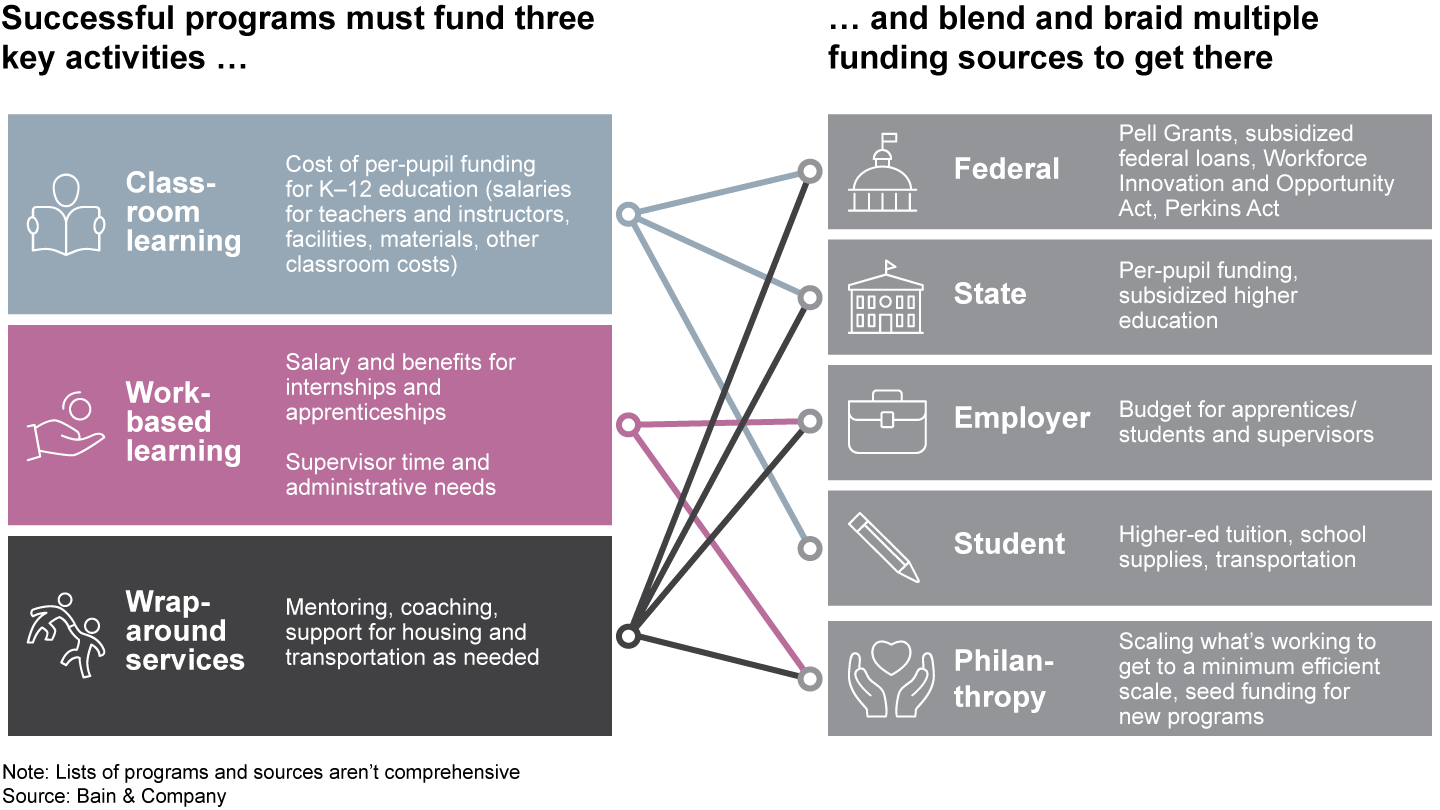
A program may achieve great outcomes for the students who participate, but if it’s inordinately expensive and needs substantial philanthropic funding to stay afloat, that model is unlikely to successfully scale. Washington addresses this by insisting that programs demonstrate that they’ll be able to sustain themselves and grow over time.
Employer economics are also an important piece of this puzzle. For employer-funded costs, financial sustainability means the investment in career-connected learning opportunities must produce a substantial, measurable return. If treated as a charitable or virtue-signaling endeavor, the program won’t last; employers won’t embrace programs that aren’t a compelling way to attract and retain the best talent. A positive return on investment means that over the life of the program, the employer portion of wages, supervision, and program management are outweighed by the productive work and overall value delivered by the student worker, and ultimately, the full-time employee. Finding this balance takes commitment, but companies are finding ways to do it. Ryan Coates of Surf Broadband, the employer mentor we introduced in Chapter 1, says his company views its apprenticeship program as a home run. “There was not a doubt in my mind that we came out on top with this program,” Coates says. “The ROI has been incredible.”
“There was not a doubt in my mind that we came out on top with this program. The ROI has been incredible.”
System builders can play a key role in helping programs navigate existing funding sources, and by creating or advocating for innovation in funding mechanisms, like the short-term Pell Grant.
In Delaware, system builders started with existing public funding and some philanthropic capital, focusing on helping programs access that funding. Luke Rhine, the director of career and technical education and STEM initiatives at the Delaware Department of Education, tells us, “At the state level, we have the ability to see and coordinate across all the different funding streams, ensuring no one is competing with each other, and directing resources where they can have the biggest impact.” Over time, though, leaders in Delaware have gone further, including passing bills in 2021 to increase funding for access to community colleges, four-year colleges, and credential programs. Each piece of legislation is notable by itself, but collectively the impact will be magnified in advancing access and opportunity in the state.
Sustainability also means embracing the art of the possible and working with what you have. We’ve seen this in programs focused on transforming the traditional 11th- and 12th-grade experience to include substantial work-based learning experiences, like youth apprenticeship programs. Several K–12 districts across the US are doing this, inspired by the Swiss model where two-thirds of young people enter apprenticeship programs in the equivalent of 10th grade. This can be enormously powerful when it works. But because it requires a sweeping overhaul of how high schools function, it can be challenging to accomplish at scale.
This is why many, including Swiss officials who have visited the US, believe the massive community college infrastructure of over 1,000 institutions serving more than 6 million students is a much better foundation for achieving scale with robust study-and-work programs than trying to reinvent high school. Says Harvard’s Schwartz, “If you look at the skills and experiences that kids have coming out of the Singapore system, the Swiss system, and you try to compare that with the US, the logical comparison is not with high school because our CTE [career technical education] programs are so limited, but with our community colleges.”
The lesson here is that scalability often requires expediency. Moving far enough, fast enough is often a function of improving existing systems and structures. The systems that have come the furthest haven’t let perfect be the enemy of good.
Motivate and reward success
The most successful system builders and governments harness the power of market incentives to change behavior and build momentum. To help expand the Arkansas computer science initiative, for instance, the Hutchinson administration invited teachers to apply for up to $10,000 in stipends to obtain a computer science certification. This added more than 225 certified CS teachers. The state also set aside reward incentives for students, who could receive up to $1,000 for scoring highly on the AP computer science exam.
In Washington, the system was kick-started by $35 million from the state government to create regional networks, scale high-impact programs, and support educators. Then, the Career Launch endorsement process helped keep the flywheel humming. Programs that pass the Career Launch review receive valuable benefits, including grant funding and an official seal of approval.
These incentives have propelled real behavior change on the part of program providers, catalyzing new program development and encouraging existing programs to expand or improve in line with higher standards. The Next Move Nursing Program in Tacoma, for instance, had been providing classroom learning, specialized training, and clinical internship experiences for 18 years. But the students weren’t paid for the time spent on the job. With the Career Launch endorsement on the line, and paid work experience a key requirement, Next Move found a way to offer stipends to interns.
In California, community college funding was explicitly tied to the use of a new data tool called the LaunchBoard. This is a database that aggregates how graduates fare, including completion and workforce outcomes. A primary goal of the tool is to light a fire for faculty and administrators, stimulating conversations about how to better prepare students for the workforce. Getting a decentralized system of more than 100 institutions to adopt this data tool required incentives and reinforcements. Leaders in state government decided to use funding as a carrot. If community colleges identified an “executive champion” and sent a team to complete training on the tool, they could unlock $50,000 of funding to overcome barriers to adoption. Teams from every one of the state’s community colleges attended the training. State funding disbursed through the Strong Workforce Program are based partly on outcomes data tied to the LaunchBoard tool.
This is a good standard. While the growing call for lower-cost access to college has the potential to accelerate the growth of career-connected learning, it should absolutely come with strings attached. When economies required that people earn a high school diploma, high school was funded for every student in most places. Strong economies now require education beyond high school, yet students too often pay a crippling amount for those credentials. For new funding to have the desired impact, however, it must be tied to what works; that is, educational organizations should be required to demonstrate evidence of strong workforce outcomes and a viable plan to scale their impact to more students and employers.
In a time of extraordinary business innovation and robust job creation, it makes no sense that so many young people walk into the working world unprepared to start a meaningful career. It doesn’t have to be that way. Accelerating career-connected learning is what doing better will look like. The good news is that momentum is building as more educators, more employers, and more policymakers recognize that “study-and-work” is not only a better way to learn, but also the best way to ensure that people from all walks of life have a fair shot at realizing their potential and achieving their dreams. Taking CCL programs to scale will provide students the opportunity to build fulfilling careers and fruitful lives. Providing real, tangible opportunity to young people will pay off in more vibrant economies. It will build a stronger and more equitable world.






















